Sweet and slightly exotic, Turkish delight is a popular Middle Eastern candy that can be made and flavored in a variety of ways. Learn how to make it at home and customize it to suit your taste.
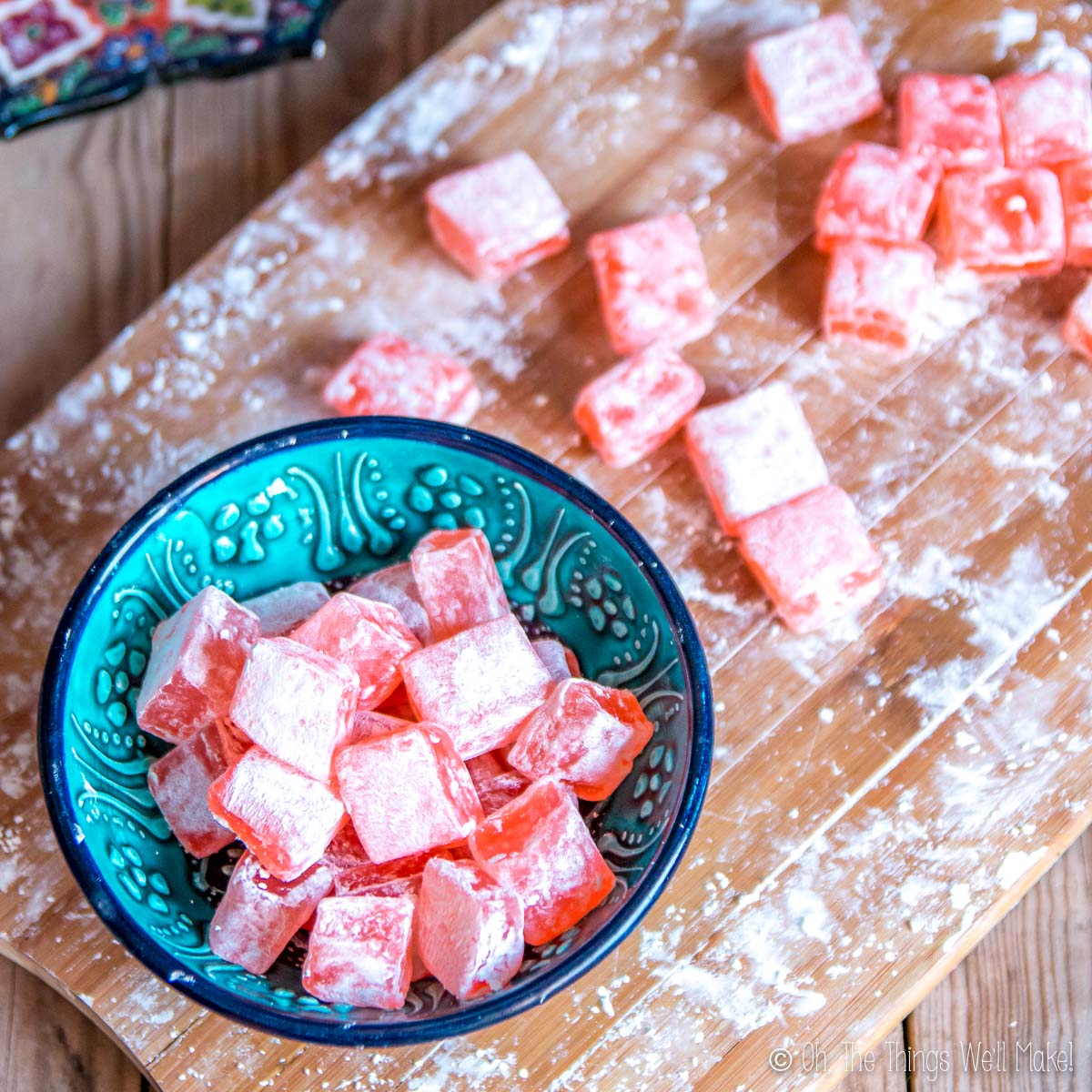
Several years ago, our family went on a European cruise that brought us to Italy, Croatia, Greece, and Kusadasi, Turkey. Of course, when cruising, you only make short stops in touristy areas. So, of course, I do not proclaim myself an expert in anything Turkish.
While I was there, though, rather than picking up an “authentic fake watch” (Yes, that was on a sign I saw!), I bought two beautiful hand-painted bowls and several boxes of Turkish delight.
What is Turkish delight?
Turkish delight, also traditionally known as lokum, is a sweet gel confection made with sugar and starch. It can be flavored in a number of ways, often with nuts, citrus fruits, and/or rose water. The most common is probably the pink-colored rose-flavored lokum, but other popular varieties use pistachios and walnuts. It’s very popular in the Middle East but has gained popularity in other parts of the world.
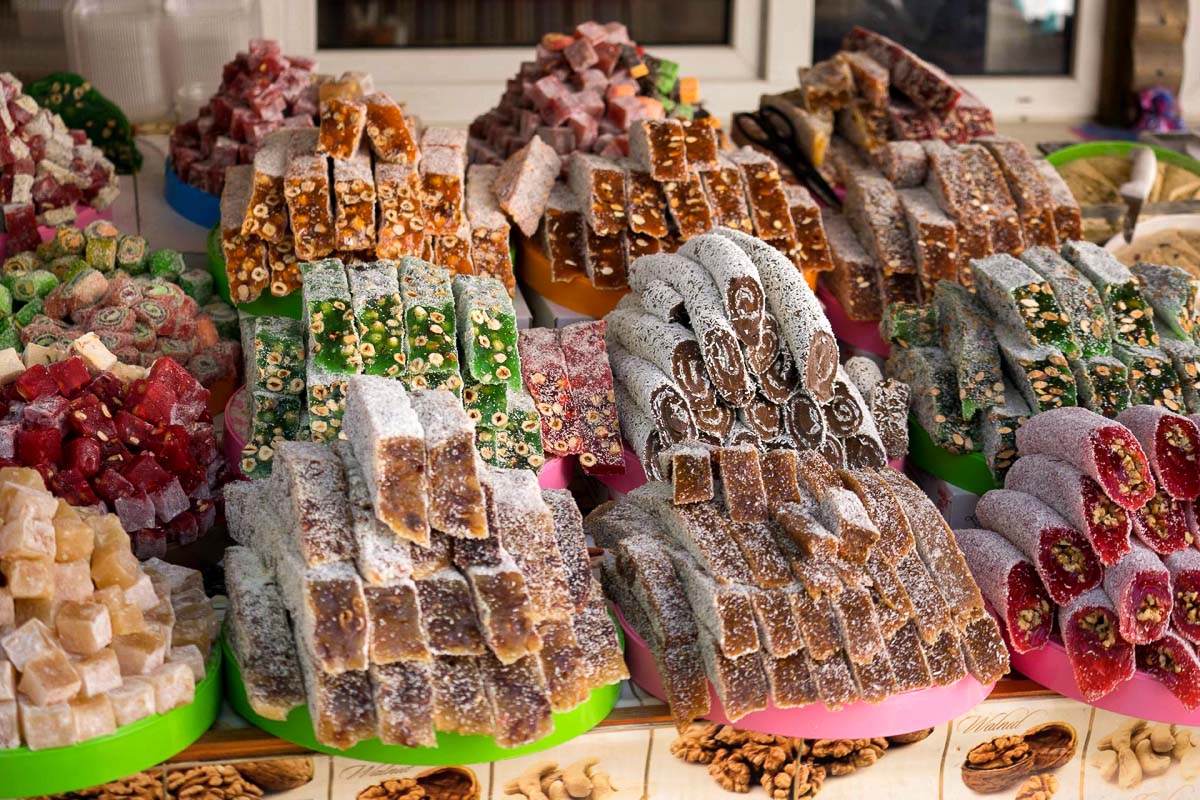
This gel-based sweet has piqued my interest ever since I watched an animated movie of The Lion, The Witch, and the Wardrobe (from the Chronicles of Narnia) at my grandparents’ house as a kid. In the story, the white witch lures young Edmund Pevensie with this delectable treat. His love of Turkish delight was enough to get him to betray his family and join her.
With my love of trying new things, especially anything exotic or with a “perfumed” type flavor (like litchees or roses), I knew I had to give it a try.
What does it taste like?
I suspected that I would like Turkish delight, but wasn’t prepared for how much I would like it. Normally, I don’t eat a lot of sweets. In fact, I really only have a hard time passing on licorice and its chewy texture.
With my first bite of rose-flavored Turkish delight, though, I was immediately taken in by its exotic flavors combined with that chewy texture that I adore. Unfortunately, the boxes I had bought were a bit deceiving. They were quite large but were well padded. I was a bit disappointed to find that I had really only brought back a few pieces of this new treat I loved so much.
The other variety I bought was more like a nougat with peanuts and pistachios. Both were delicious.
Making a traditional Turkish delight
So, I was determined to learn to make Turkish delight from scratch at home. After seeing numerous recipes, I figured making it must be easy. Unfortunately, after numerous attempts, I wasn’t completely happy with the outcome. I ended up with a sweet treat with a delicious rose flavor, but felt that it lacked a bit of chewiness.
Traditional Turkish delight is made with a starch and sugar. You have to play with the gelling of the starch and the hardening of the sugar mixture to get the right texture. (In contrast, some modern versions use gelatin or a similar gelling agent to achieve its characteristic chewiness.) While my boxes of Turkish delight had corn starch as the main starch used, I imagine that the truly traditional versions of this treat called for other starches instead.
When I published my first Turkish delight recipe on this blog, I used corn starch (as most recipes do) and avoided adding wheat because I was testing out a gluten-free diet at the time. (Wheat flour was on the list of ingredients of the lokum I had bought.)
Many people enjoyed the recipe, but I still wasn’t happy. I didn’t get consistent results with the recipe and found it to be finicky. I also wasn’t sure about the texture achieved with corn starch alone.
What didn’t work
While my first attempts resulted in a flavor that was spot-on, the texture was a lot lighter and softer, not at all chewy like the Turkish delight I had bought in Turkey. So, I tried numerous times to get it right.
I’m almost embarrassed to say how many times I have tried to make this.
Experimenting with the texture
When you rely on the cornstarch to thicken the candy, you end up with a semi-solid mass of candy, but it is more like a solid gel and not at all chewy. On the other hand, a chewy candy such as taffy is made by achieving a certain temperature with a mixture of sugar and water. So, I decided to experiment using different temperatures for the sugar and water mixture.
During my first attempts, I brought the sugar to 240ºF, just above the point where the sugar is inverted (more on that in a sec), and then added in the cornstarch solution. I ended up with a rose-flavored jelly treat that wasn’t at all chewy. It was sort of gelatinous in texture (although that doesn’t really describe it well either).
I then tried heating the sugar solution to the hardball stage before adding in the cornstarch solution. The result? A chewy Turkish delight that wasn’t so powerfully sweet, but with a caramelized sugar flavor reminiscent of flan.
The challenge was to get something in between.
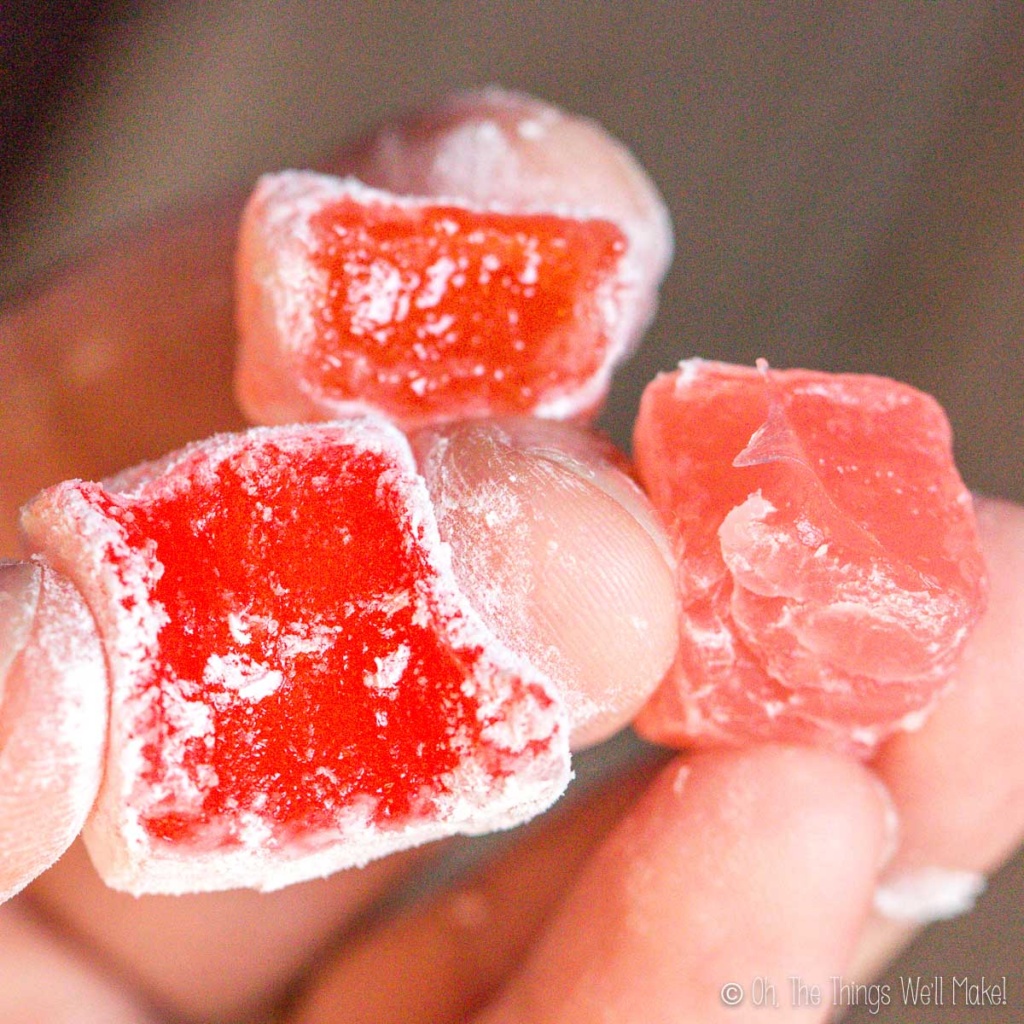
Comparing the textures of the store bought Turkish delight (left, bottom) to a softer, early attempt (right, bottom) and a chewier version (top) 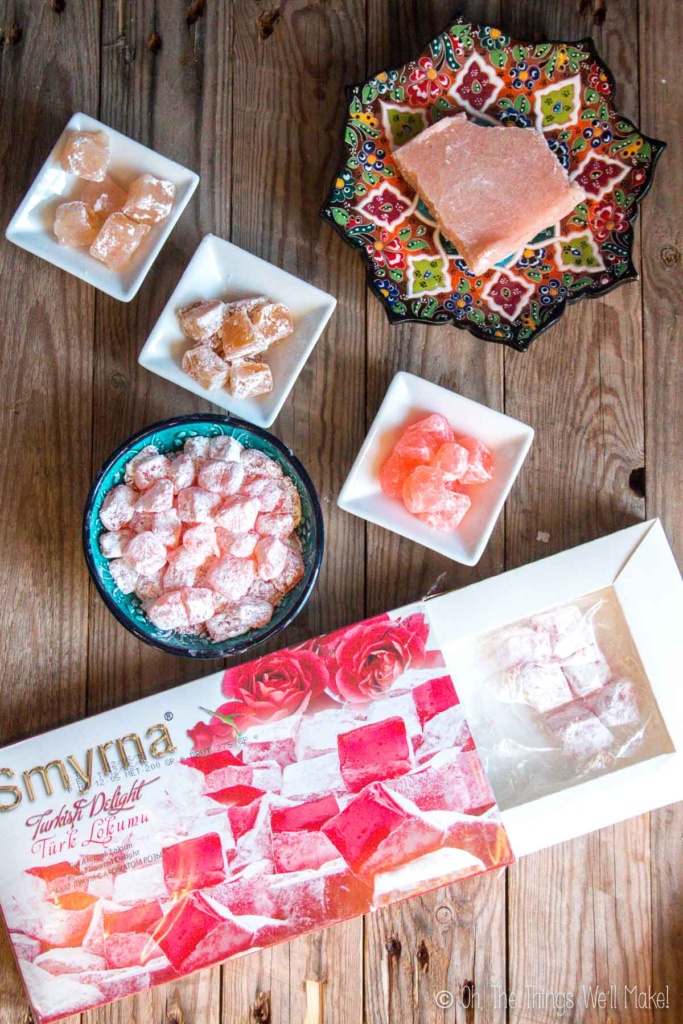
Various attempts at Turkish delight by the boxed candy I bought in Turkey. 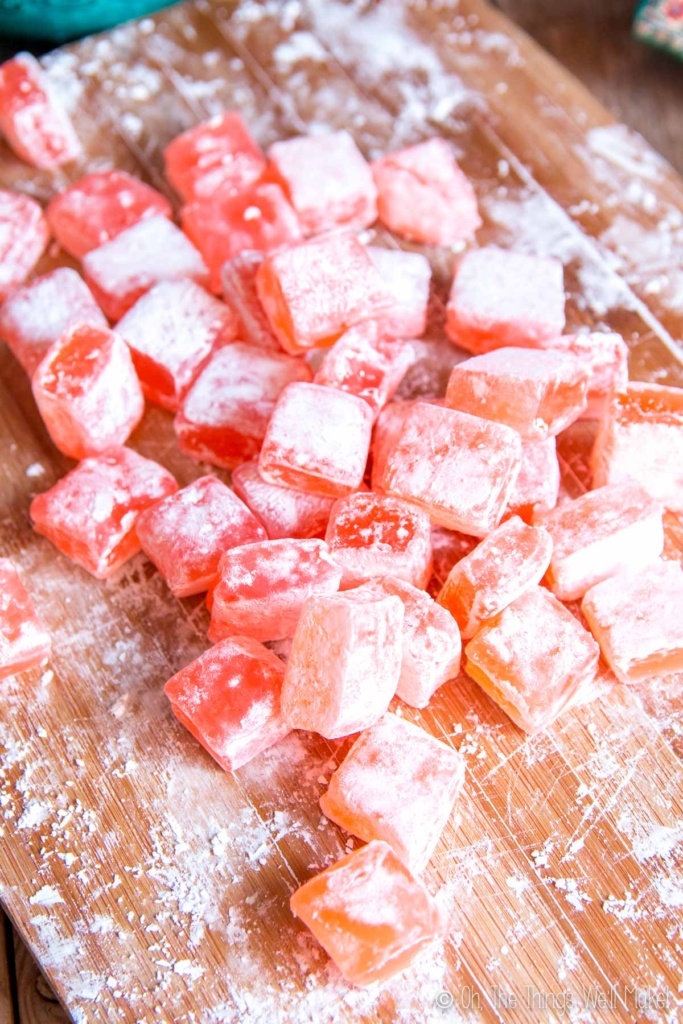
Two versions of homemade Turkish delight
In my first published recipe, I settled on heating the syrup to 260ºF. (Even at that temperature, though, the candy can take on a more caramelized flavor.)
Unfortunately, with that first recipe, I found there was a lot of room for error, even when following the recipe carefully and monitoring temperatures along the way. The final result depended on the cooking time, the humidity of the cooking space, etc.
I have since found that using other starches is the key to getting great texture without all of the hassle.
Adding the starch mixture
Many recipes online tell you to make a sugar syrup first and then make a separate paste out of the starch (normally cornstarch) and water. You are then supposed to mix everything together and cook the mixture longer. While I tried that method first, I didn’t see any benefit to making a separate paste out of only starch and water. It only made for difficult blending later on. Instead, I found it much easier to add an uncooked mixture of water and cornstarch to the sugar syrup and cook them together to thicken them.
From what I have read about Turkish delight production, it seems to be the usual way of making it anyway.
Adding the flavoring
Most recipes have you add the rosewater or other flavorings right before pouring the mixture into the mold, once you’ve achieved the desired consistency.
Adding flavorings such as rose water at the end, though, adds more moisture to the mixture. That, of course, inevitably changes the final texture, softening the candy. I’ve found that with my new recipe, it’s fine to add the rose water as part of the water used at the beginning. The flavor holds up quite well through the cooking process.
Another option? I found a recipe from a Turkish girl who flavored her Turkish delight with rose oil. While that sounds like a great solution, it’s also an expensive one for most of us.
Ingredients
So, after years of experimentation, I’ve finally found a recipe that I’ve been able to reproduce successfully several times now. The key to getting the texture and flavor I wanted was to use a different starch.
My first success used a 50/50 mixture of wheat flour and cornstarch. The wheat flour helped get a chewy texture that worked really well for this recipe. Still, it was tricky to cook it down enough to get the candy firm enough. (Those who’d like to give it a try, though, can substitute out half of the cornstarch in my original cornstarch-based recipe.)
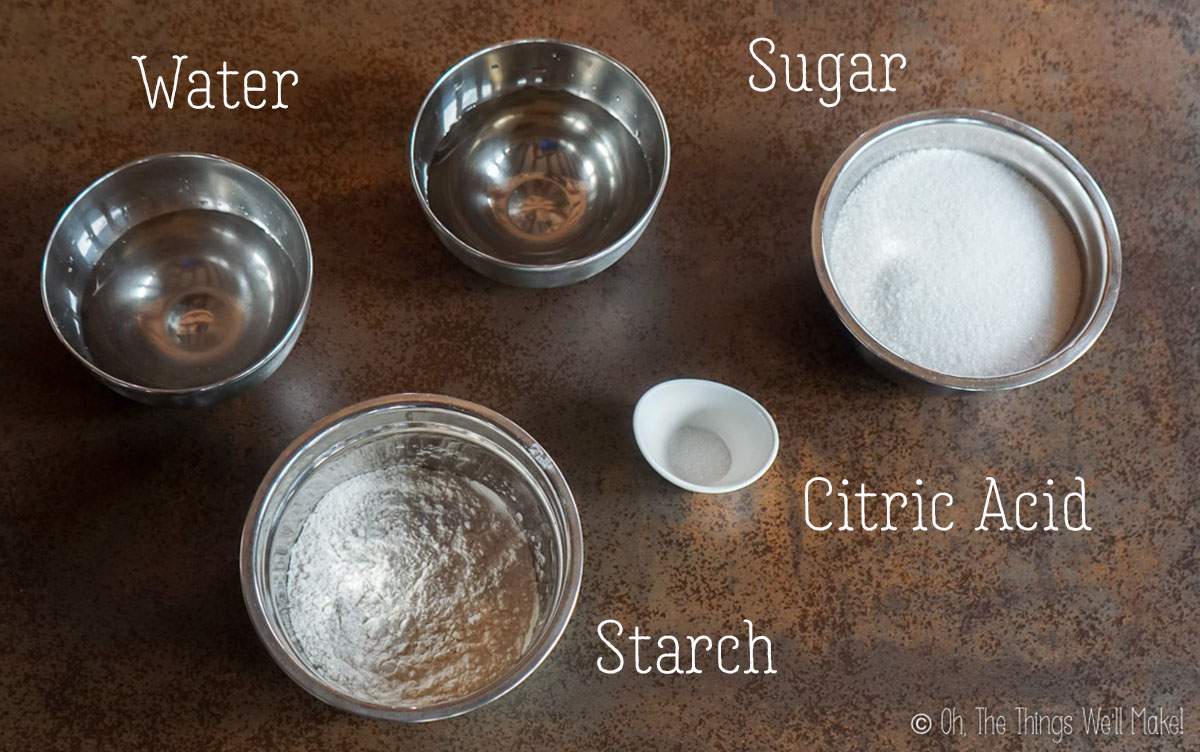
In the end, my favorite version uses rice flour instead of cornstarch.
Other than the rice flour, I used white sugar, water, and some citric acid. I flavored my candy with rosewater, but you can add other flavorings instead. If you want to make pink candy, you’ll also want to use some red food coloring. (On my first attempt, I used homemade beetroot powder and it worked quite well as a natural food coloring!)
Perhaps in the future I’ll try with other starches. I’d love to hear from those of you who have done that sort of experimentation!
Does it need cream of tartar?
Most recipes for Turkish delight use cream of tartar, many insisting that it’s very important for the recipe. My conclusion, after some investigation, is that the cream of tartar is only being used to acidulate the mixture. The sugar syrup you make at the beginning is also known as invert sugar. It helps keep your final candy from crystalizing.
As cream of tartar isn’t easily available in Spain (nor was it listed on my box of Turkish delight), I used citric acid instead. To make invert sugar you slowly cook the water, sugar, and citric acid (or cream of tartar) until you end up with a syrup around 236ºF. If you don’t have citric acid, you can also use lemon juice to bring down the pH.
Incidentally, some recipes added the cream of tartar to the cornstarch mixture rather than to the sugar syrup. I’m not really sure what they were intending to do, but I feel like they sort of missed the point of what the cream of tartar was actually meant to do.
Making Turkish Delight with Cornstarch
Before beginning, prepare the mold you plan on using. I used a small silicone mold greased with coconut oil. If you don’t have silicone pans, line a small baking pan with wax or parchment paper. (Consider greasing the paper with oil or butter to keep the candy from sticking to it.)
Mix together the sugar, water, and citric acid in a heavy bottom pan over medium to high heat. Bring the mixture to a slight boil before lowering the heat.
Continue to cook the mixture over low to medium heat until you reach 240ºF. While you shouldn’t stir the mixture throughout the process (as this can affect the temperature), you can occasionally use a spatula to wipe down any sugar crystals from the side of the pan.
As the sugar syrup cooks, mix together the cornstarch, water, and rose water.
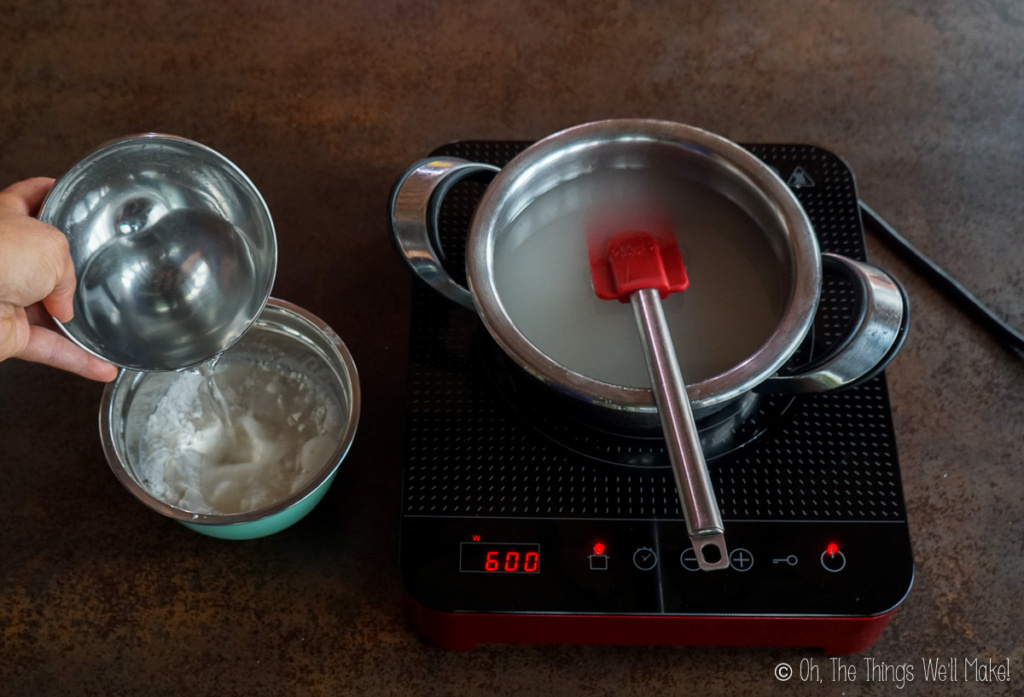
Mix starch and water. 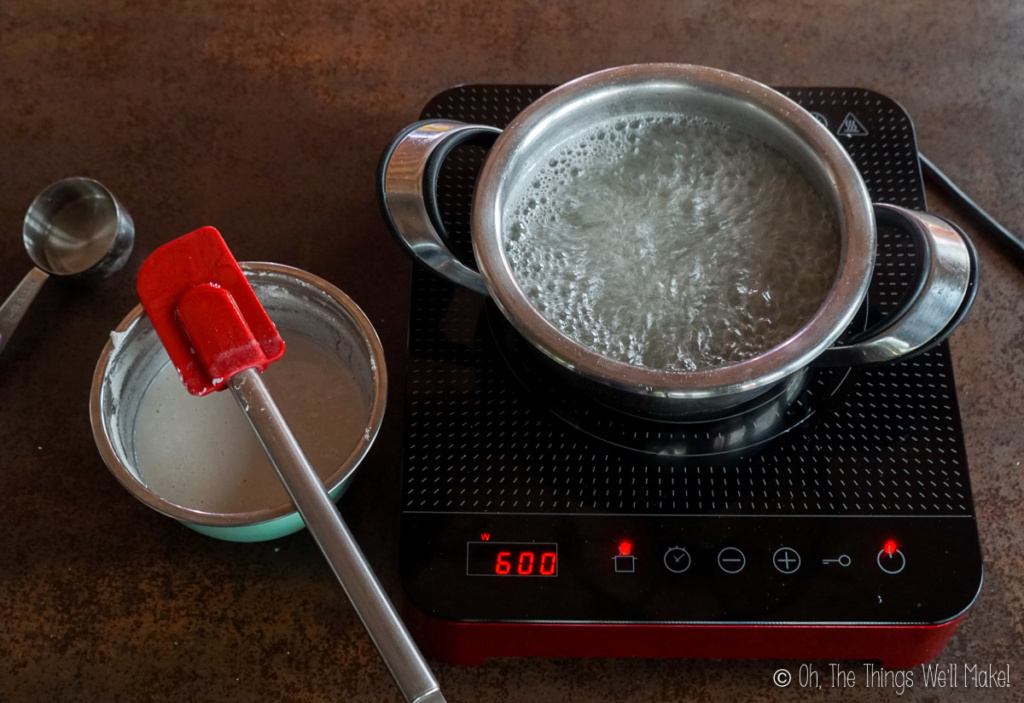
Bring sugar syrup to 140ºF. 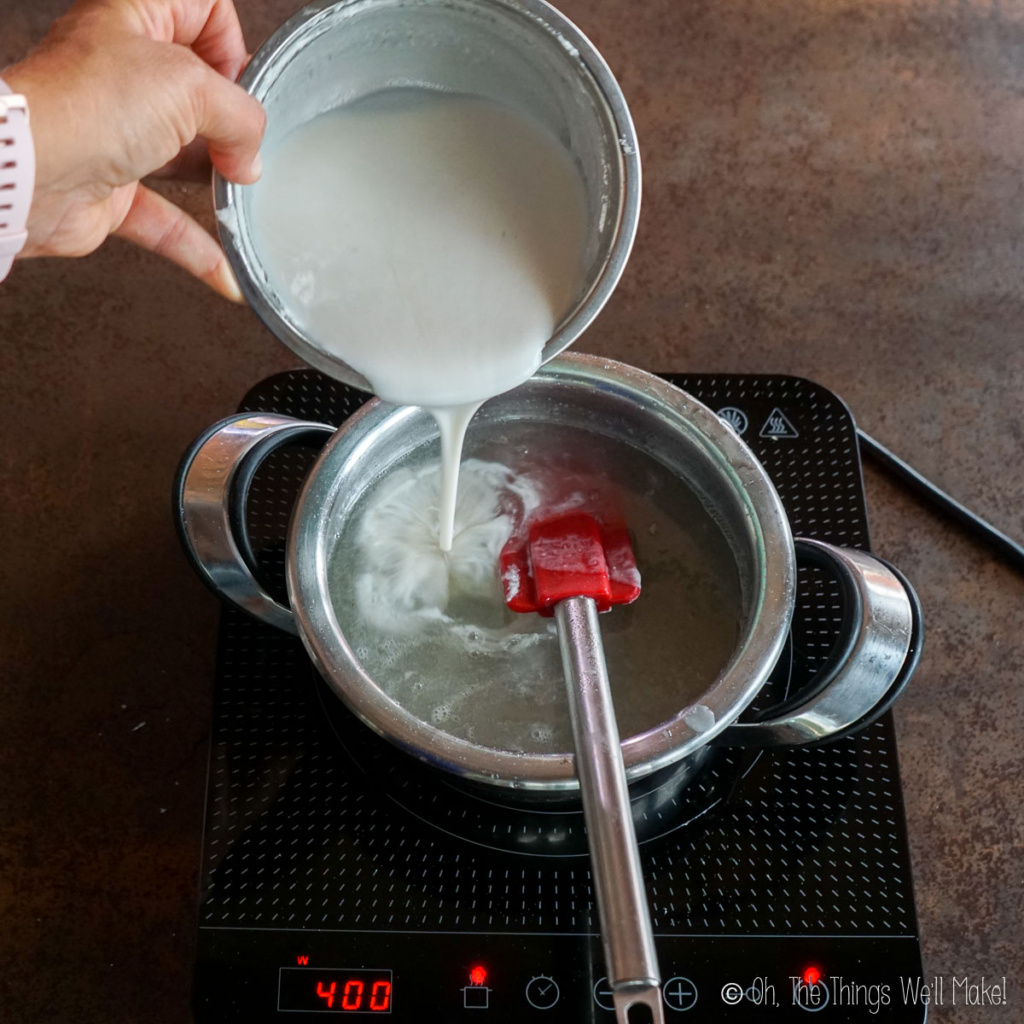
Add the starch mixture to the sugar syrup.
When the sugar syrup reaches the right temperature, take it off the heat source. Pour some of the sugar syrup into the starch solution to warm it. Then, drizzle the starch mixture into the hot sugar syrup while continuously stirring them together.
Once combined, cook the mixture over low heat, stirring constantly. It should soon get quite thick. If you have a hard time removing the lumps, you can use an immersion blender to help achieve a smooth texture.
To achieve a chewy candy, you will want to reduce and thicken it even more. That can be achieved by cooking it for quite some time over low heat until you get the desired consistency.
Check the consistency by adding some of the hot mixture to cold water to cool it. When the cooled mixture can be shaped well and hold its shape, the mixture is ready and you can pour it into the prepared mold. Spread it out as best you can with a spatula. It should be very thick and sticky.
Let cool for several hours.
Unmold the mixture onto a clean counter sprinkled with cornstarch. Cut the candy into small squares with a sharp knife, coating each of them with cornstarch to keep the candies from sticking to one another.
Preventing sticking
Most recipes call for coating the candy with powdered sugar or a combination of powdered sugar and cornstarch to prevent them from sticking to one another. The Turkish delight I bought in Turkey was only dusted with cornstarch and not with sugar. Turkish delight is already very sweet. Plus, the candy may “sweat” causing the sugar coating to “melt” off of the candy. That’s why I don’t recommend coating the candy in powdered sugar.
I recommend coating the candy with the starch you’ve used instead. If using sugar, you may have to add starch to it or reapply the coating before serving your candy.
Making Turkish delight with rice flour
You can probably guess by my introduction, that my new favorite method for making Turkish delight uses rice flour. The process is simpler, and I prefer the result. You don’t even need a candy thermometer!
To make Turkish delight with rice flour, mix together all of the ingredients in a saucepan. Whisk the ingredients together, concentrating on getting out any lumps. Cook the mixture over medium to high heat until it begins to boil. Then, lower the heat to low to medium, stirring often.
As you cook the mixture, it will get thicker and thicker. It will also turn a more golden color. When you notice it changing color and getting quite thick, turn the heat down to very low, stirring occasionally.
Check on the candy by placing some of the mixture into very cold water. When you can form it and it holds its shape, it’s ready to pour into a prepared mold. (Silicone molds can be greased with butter or oil. Other molds can be lined with a clean cloth covered with a thick layer of starch or lined with parchment paper that has been greased with oil or butter.)
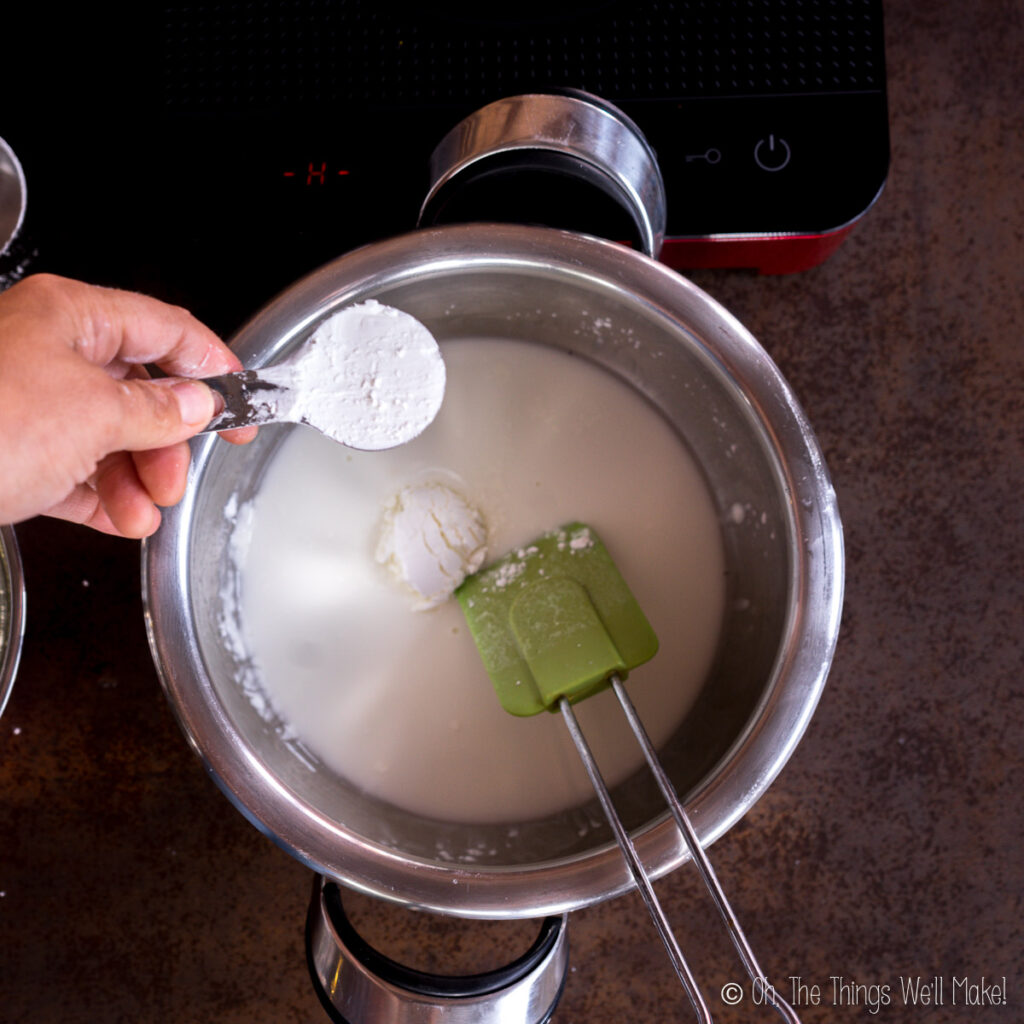
Combine all ingredients. 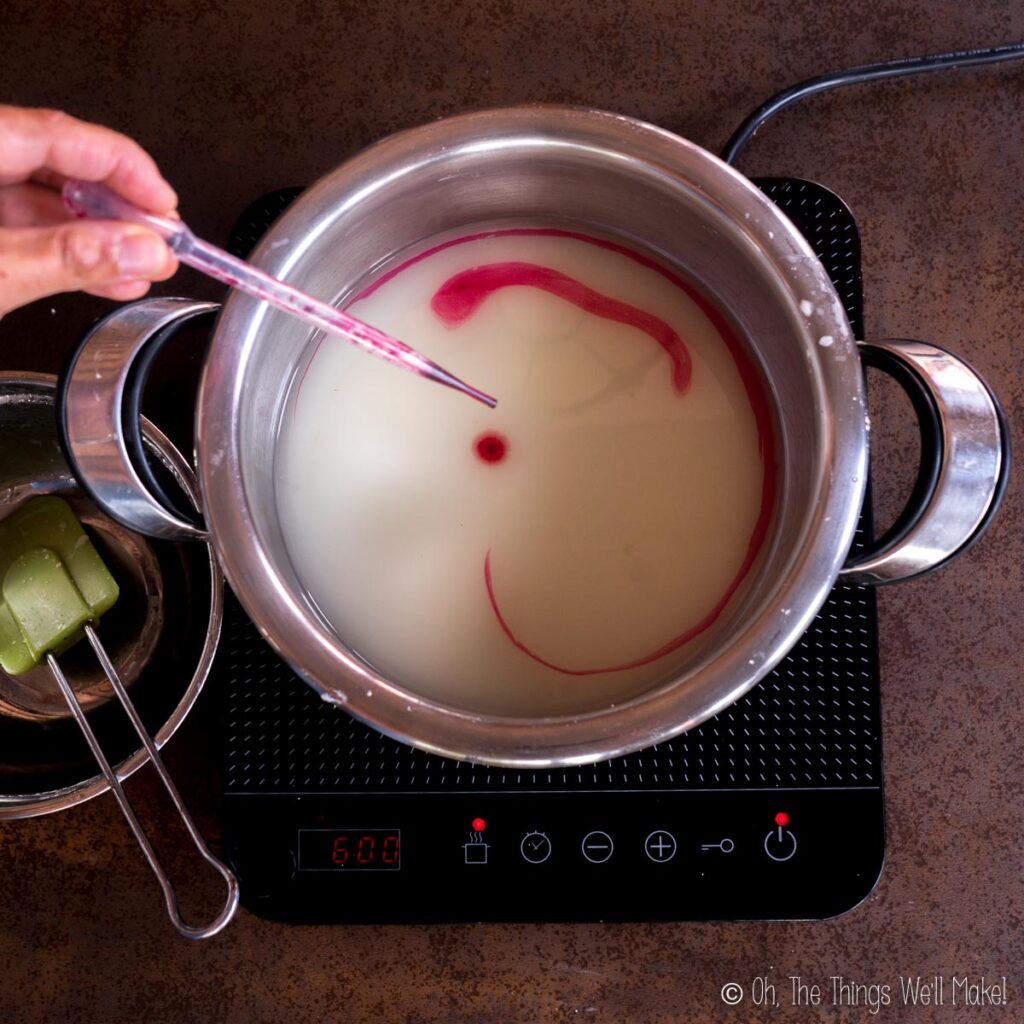
Optionally, add food coloring. 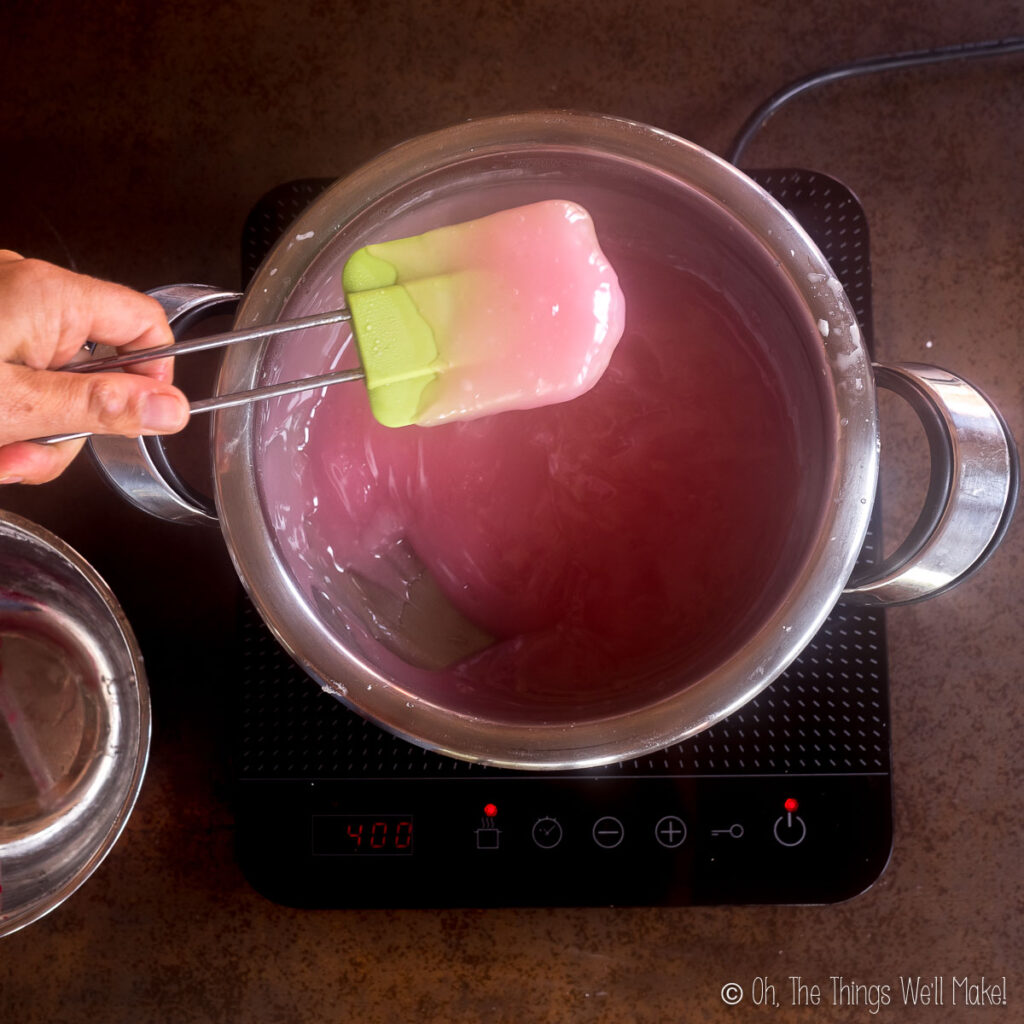
Cook until thickened. 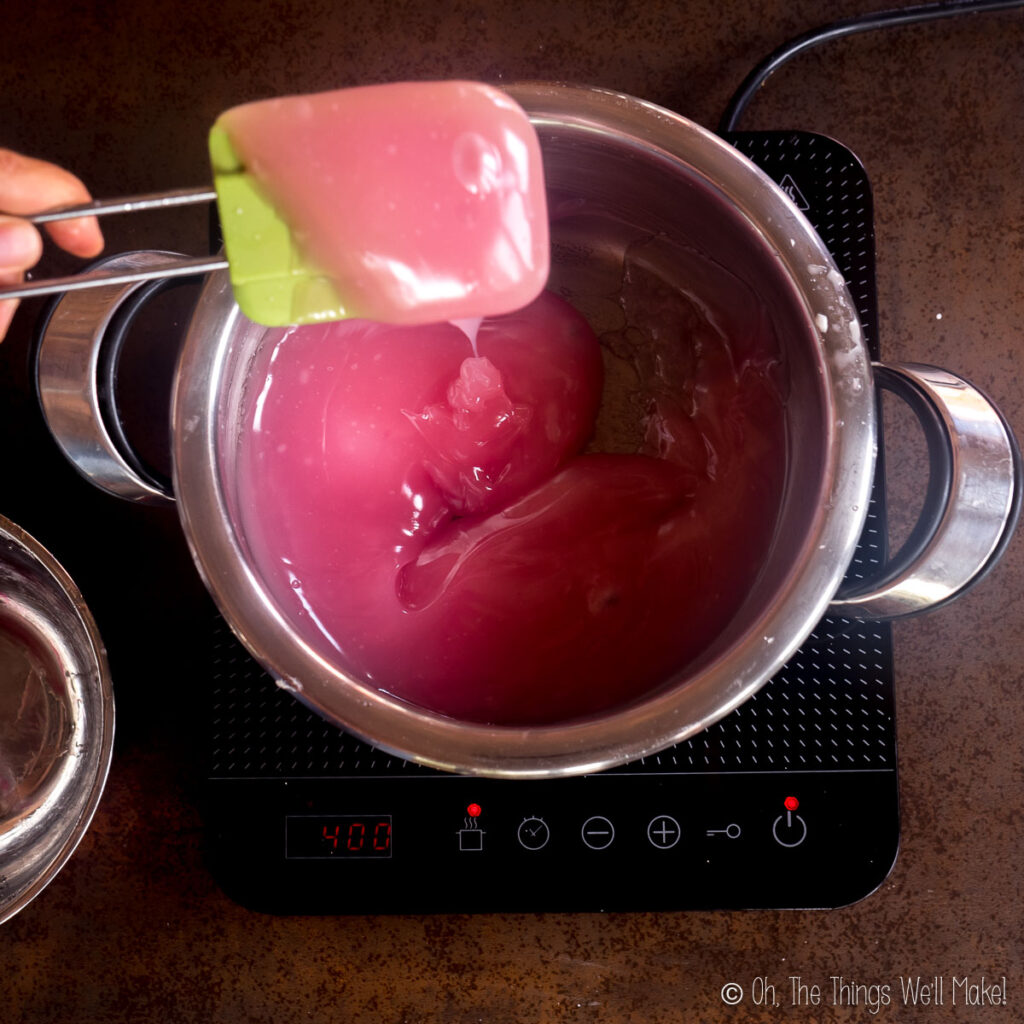
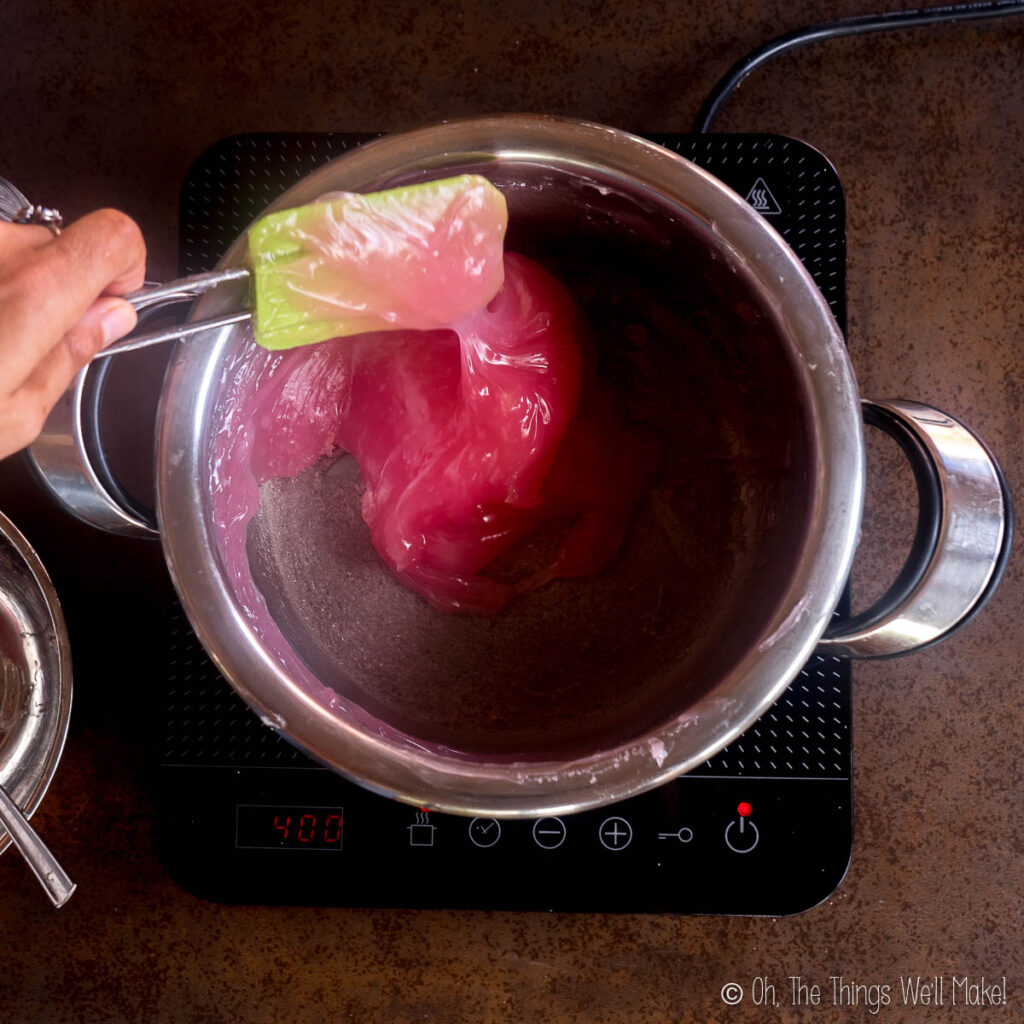
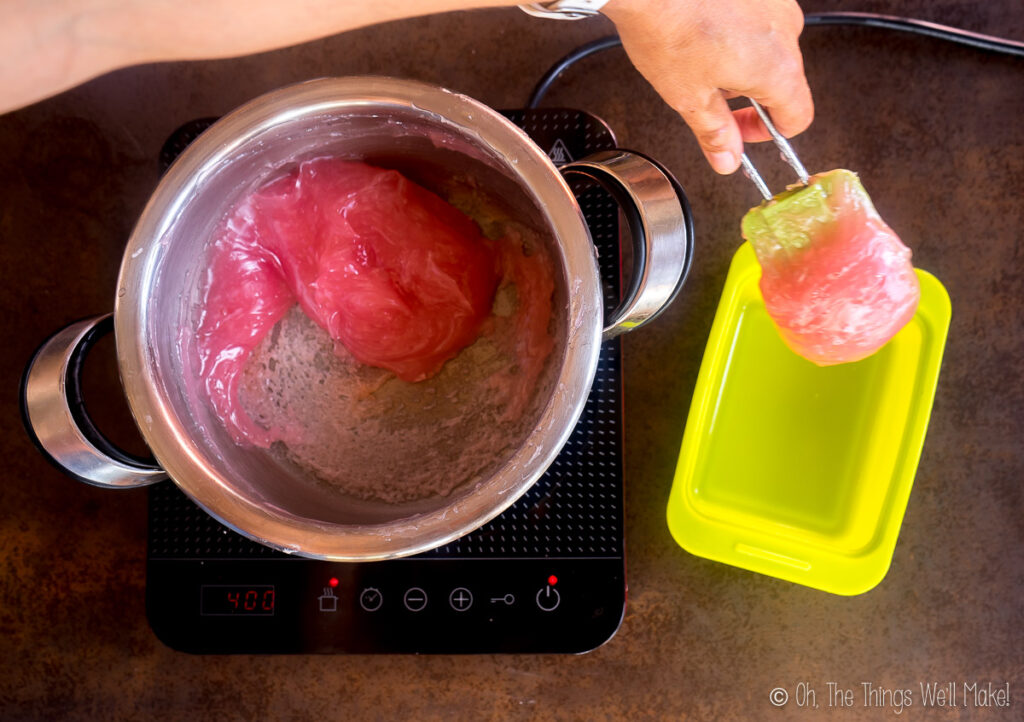
Allow the candy to fully cool before cutting into small pieces.
Troubleshooting
The trickiest part of making Turkish delight is to get the texture just right. If you don’t cook the mixture long enough to evaporate off all of the excess water, the mixture won’t be firm enough.
Some people prefer a softer Turkish delight. To obtain that, it won’t be as necessary to cook off as much moisture.
I, on the other hand, prefer the candy to have a bit of “bite”. To fix a batch of soft Turkish delight, you can reheat it and continue cooking off the excess water. You can then pour it back into the mold when you feel it’s ready.
Trying to cook off all the water, though, is easier said than done. Even on low heat, it’s easy to start caramelizing the mixture (or even burning it) when there isn’t a lot of water left. To prevent that, you should continuously stir it, but there is an easier way…
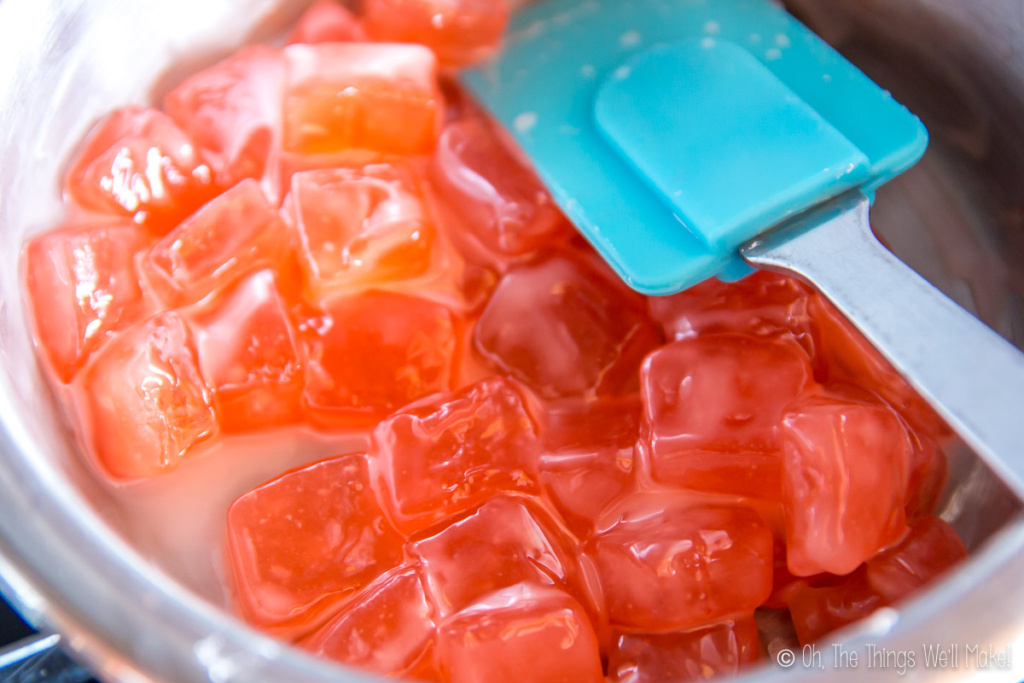
Melting Turkish delight to further cook it. 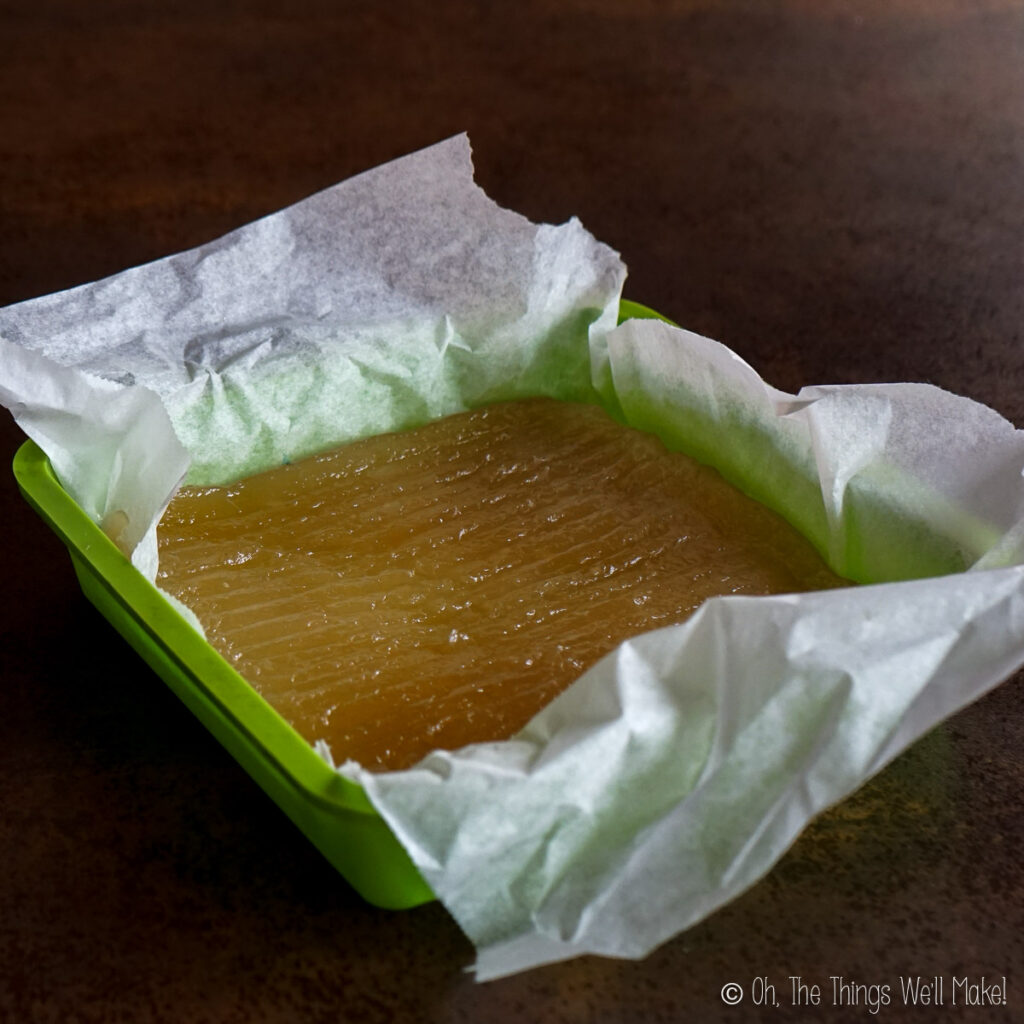
Baked Turkish delight 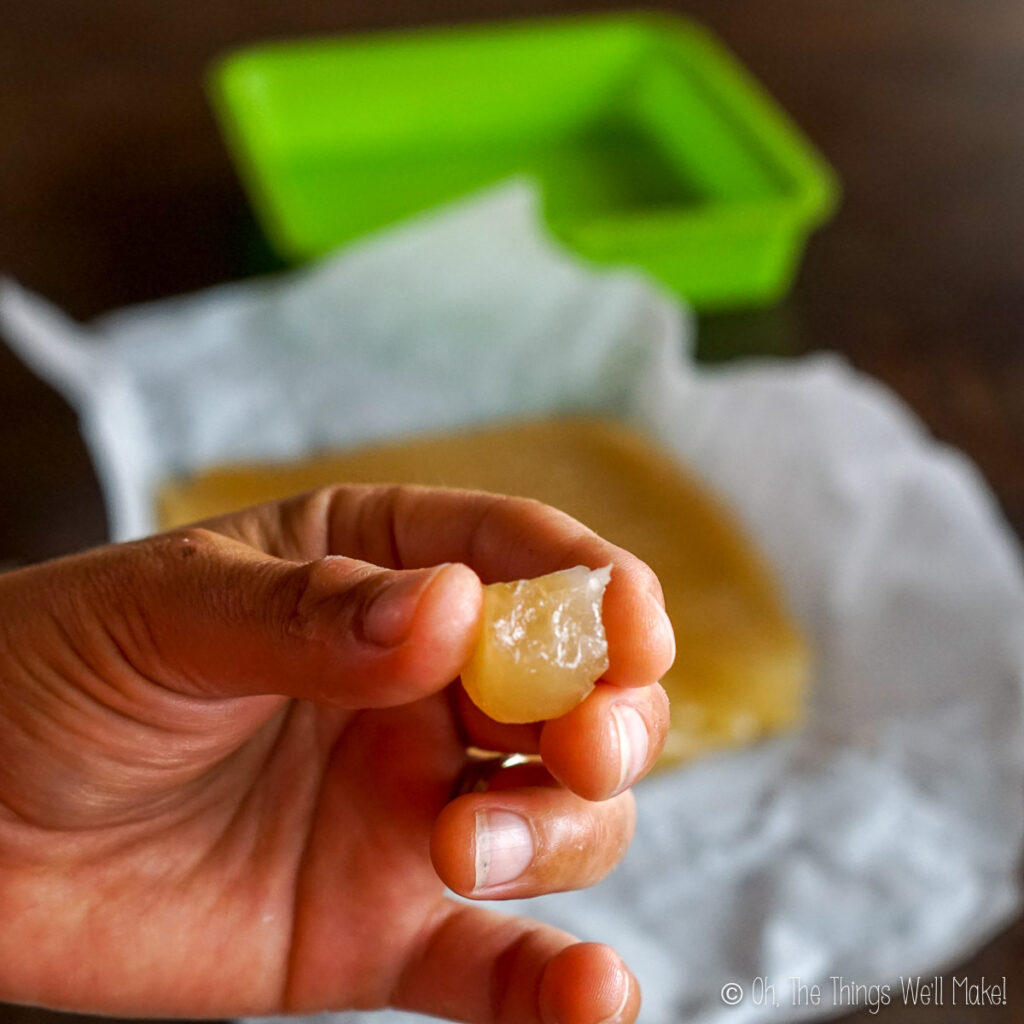
A great trick I’ve found is to bake the almost finished mixture directly in the mold! This allows you to gently heat and evaporate away the excess water without overly cooking and caramelizing the sugar! If you try this method, keep the oven at its lowest setting. (I bet a dehydrator would also work well!)
Storage
Store Turkish delight in an airtight container at room temperature, coated in starch. Because of the high sugar content and the low moisture, it is safe to eat for many weeks/months, but will lose freshness with time.
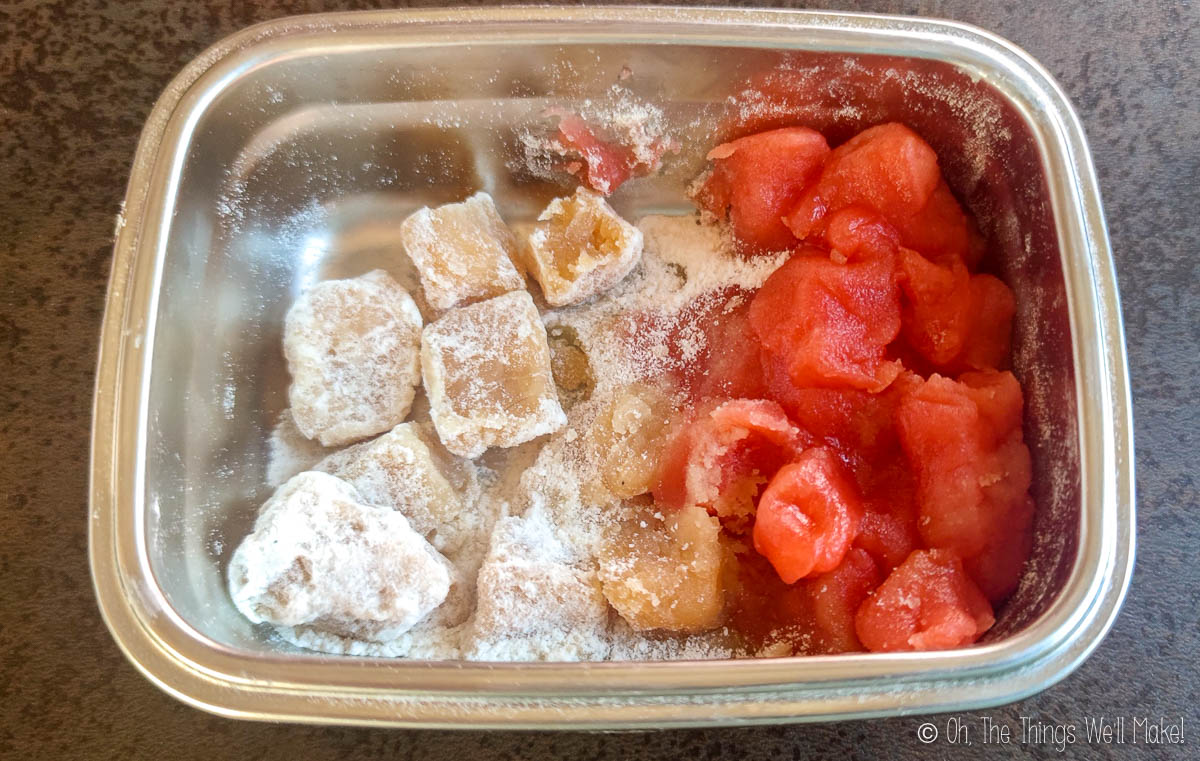
I’ve found that the Turkish delight made with cornstarch is more likely to “sweat” and become soggy with time while the one made with rice flour gets dry with time.
Video
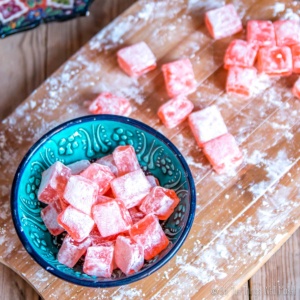
Traditional Turkish Delight Recipe (Using Cornstarch)
Ingredients
- 2 cups sugar
- ¾ cup water
- ⅛ teaspoon citric acid or lemon juice or cream of tartar
- ½ cup water
- ⅝ cup cornstarch
- Rose flavor to taste- rose water, syrup, or oil
- Red coloring (optional)
- extra cornstarch for dusting
Instructions
- Prepare your molds. I used silicone molds greased with coconut oil. If you don’t have silicone pans, line other pans with greased wax or parchment paper. (The final candy will be sticky, and that will help with the unmolding process.)
- Begin by mixing together the first 3 ingredients (sugar, 3/4 c. water, and citric acid) in a heavy bottom pan, and bring to a slight boil before lowering the heat.
- Heat, without needing to stir, over low to medium heat until you reach 260ºF. You can occasionally use a spatula to wipe down any sugar crystals from the side of the pan throughout this process.
- Meanwhile, mix together the solution of cornstarch and the remaining ½ cup of water.
- When the sugar syrup has reached the right temperature, temporarily take it off the heat source and ladle in a bit of the sugar syrup into the cornstarch mixture to warm it.
- Slowly drizzle the cornstarch mixture into the sugar syrup while continuously stirring them together.
- Once all of the cornstarch solution has been completely incorporated, begin to stir the mixture over low heat. You will notice that the mixture should get quite thick almost immediately.
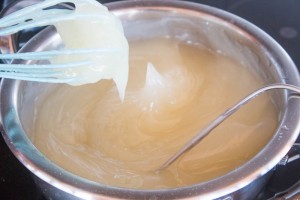
- Despite the fact that the mixture is quite thick, you will want to reduce and thicken it even more before adding in your flavorings. I found it was best to keep the mixture over a low heat so that the sugar wouldn’t caramelize on the bottom, affecting the flavor of the final product.
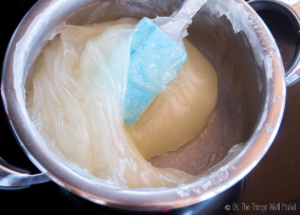
- As you heat and stir, you should notice that the gel becomes quite transparent. It will also reduce slightly in volume.
- To determine the point when you should add your flavoring, test the consistency of your candy by dipping a spoon into the gel, and then dipping the gel covered spoon into a glass of ice water. As the candy cools, you can judge the consistency and stop when you are happy with it. The longer you cook the candy at this stage, the chewier it will become and the more it will hold its shape at room temperature.
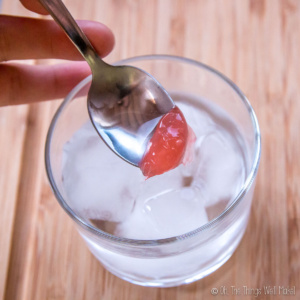
- Add in your flavorings and colorings. I wanted a strong rose flavor like the one in the turkish delight I bought in Turkey so I used a combination of 2 Tbsp. rose water, and 2 Tbsp. rose syrup. (In the first trials, I used only rose water, and it seemed to be enough for the softer versions of the candy. As you heat it more, though, the flavor gets more subtle, so I needed to add more flavor to compensate for that. You can check the flavor when you check the texture in ice water.)
- Once you’ve incorporated all of your flavorings, check the texture once more to make sure that the addition of any new liquids hasn’t affected the consistency of your candy too much. If necessary, slightly mix and warm your mixture a little longer at very low heat to help evaporate a little water, but be careful and take into account that doing this for too long can alter and diminish the flavorings you have added.
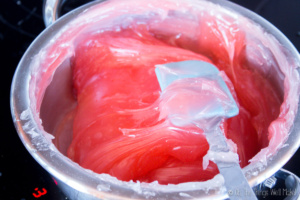
- When you are happy with your result, pour the mixture into your prepared molds and spread it out as best you can with a spatula. It should be very thick and sticky.
- Let cool for several hours.
- Cut into small squares, using cornstarch to keep the candies from sticking to one another. All of the recipes I found online either used powdered sugar or a combination of powdered sugar and cornstarch for dusting the candies, preventing them from sticking to one another. The turkish delight I bought in turkey was only dusted with cornstarch and wasn’t dusted with sugar, something I find to be unnecessary as the turkish delight is already very sweet. If you do choose to use powdered sugar for dusting, keep in mind that the candy may sweat and the sugar coating may end up “melting” off of the candy so you may have to add in more cornstarch or reapply the coating before serving your candy.
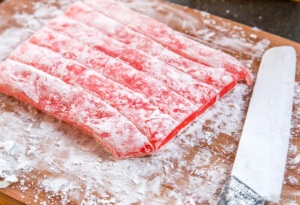

Turkish delight (Rice Flour version)
Ingredients
- 2 cups sugar
- 1 cup rice flour
- ¾ cup water
- 2 tablespoons rose water
- ⅛ teaspoon citric acid
Instructions
- Prepare a mold for the candy. Silicone molds can be greased with butter or oil. Other molds can be lined with a clean cloth covered with a thick layer of starch or lined with parchment paper that has been greased with oil or butter.
- Mix together all of the ingredients in a saucepan, whisking to remove lumps.
- Cook the mixture over medium to high heat until it begins to boil. Then, lower the heat to low to medium, stirring often.
- As you cook the mixture, it will get thicker and thicker. It will also turn a more golden color. When you notice it changing color and getting quite thick, turn the heat down to very low, stirring occasionally.
- Check on the candy by placing some of the mixture into very cold water. When you can form the cooled mixture and it holds its shape, it's ready to pour into the prepared mold.
- Allow the candy to fully cool before cutting into small pieces.
This post was originally published on July 28, 2015. It was rewritten, adding a new rice flour recipe, new photos, and improvements to the recipe instructions.
 Español
Español
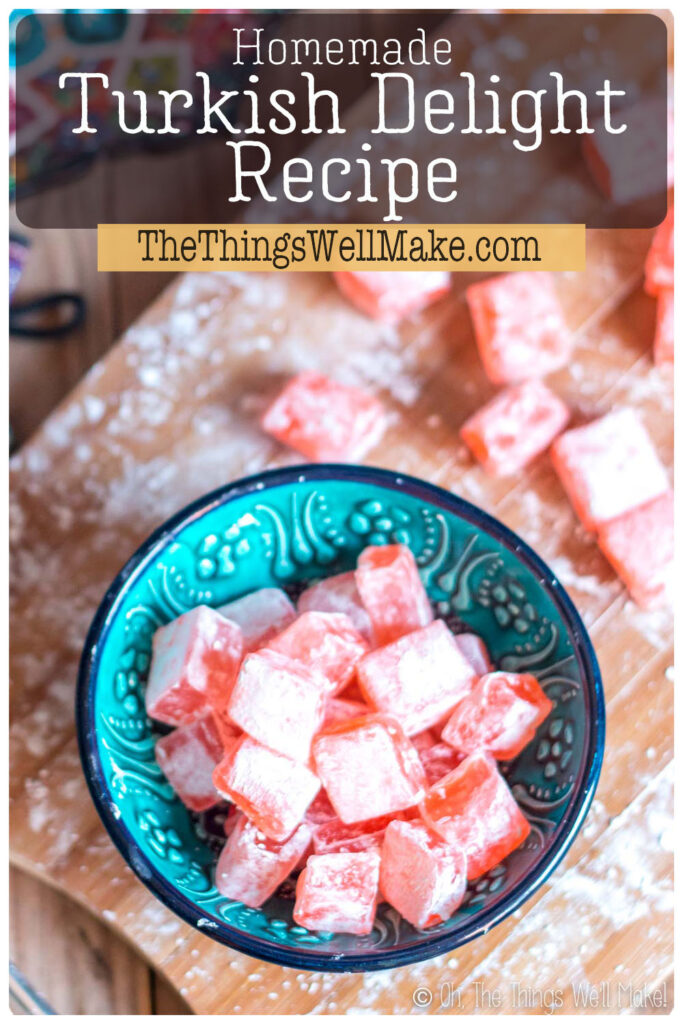
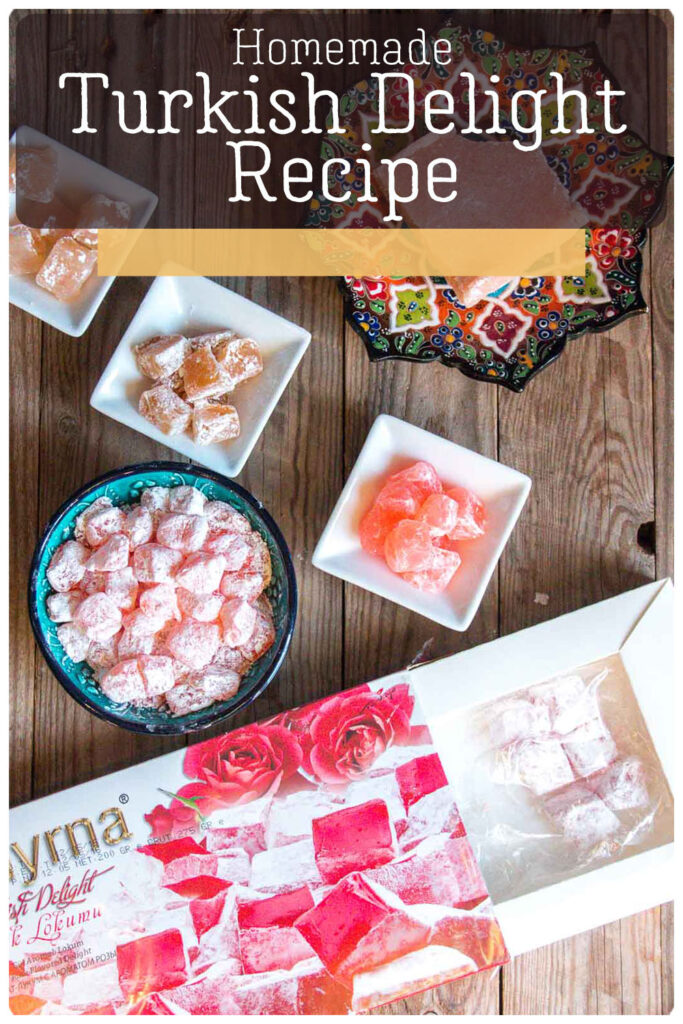
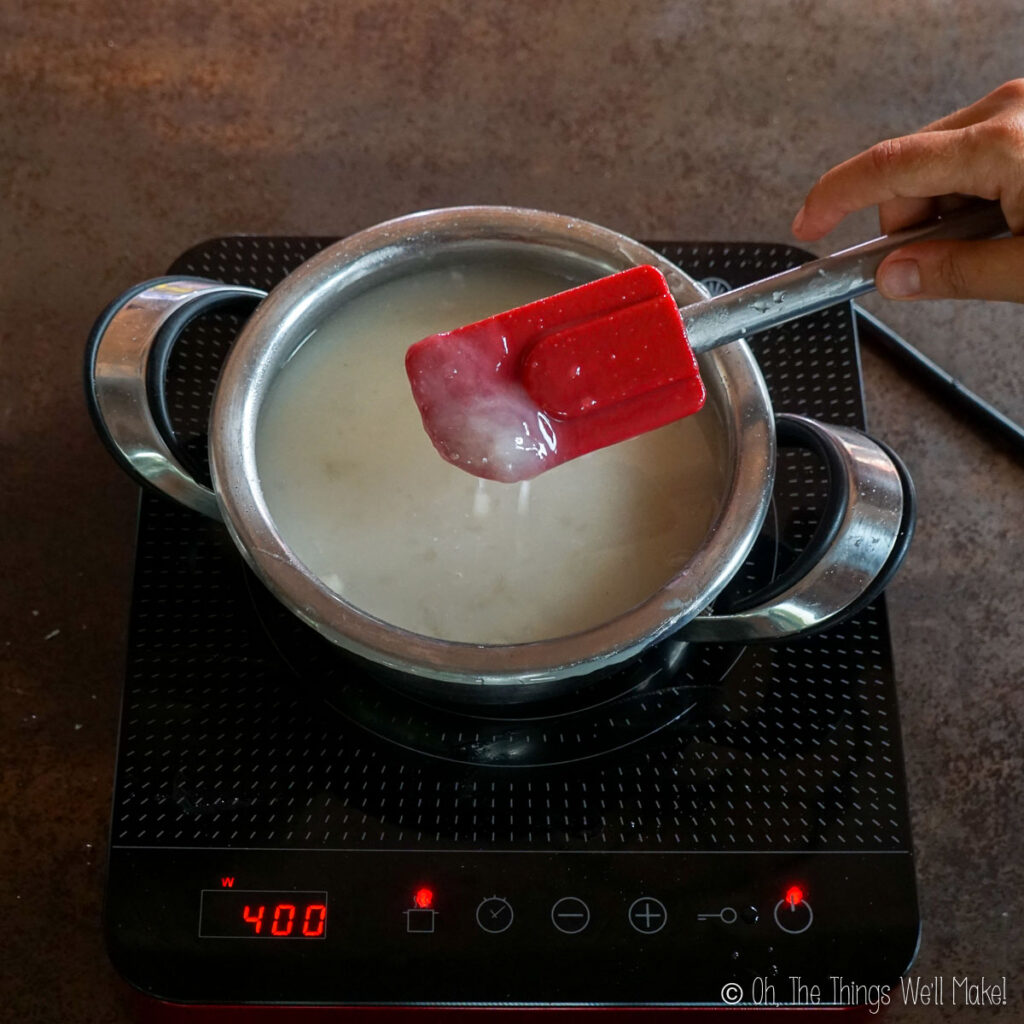
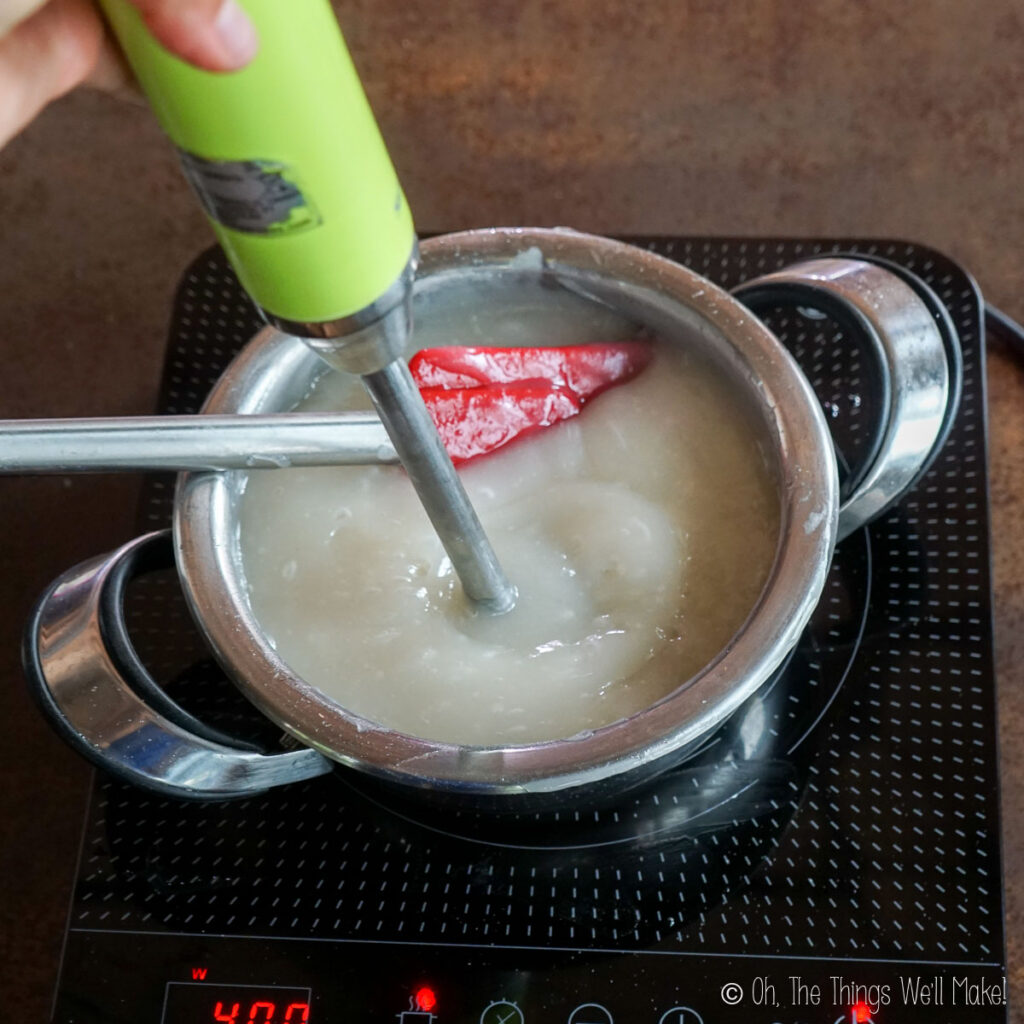
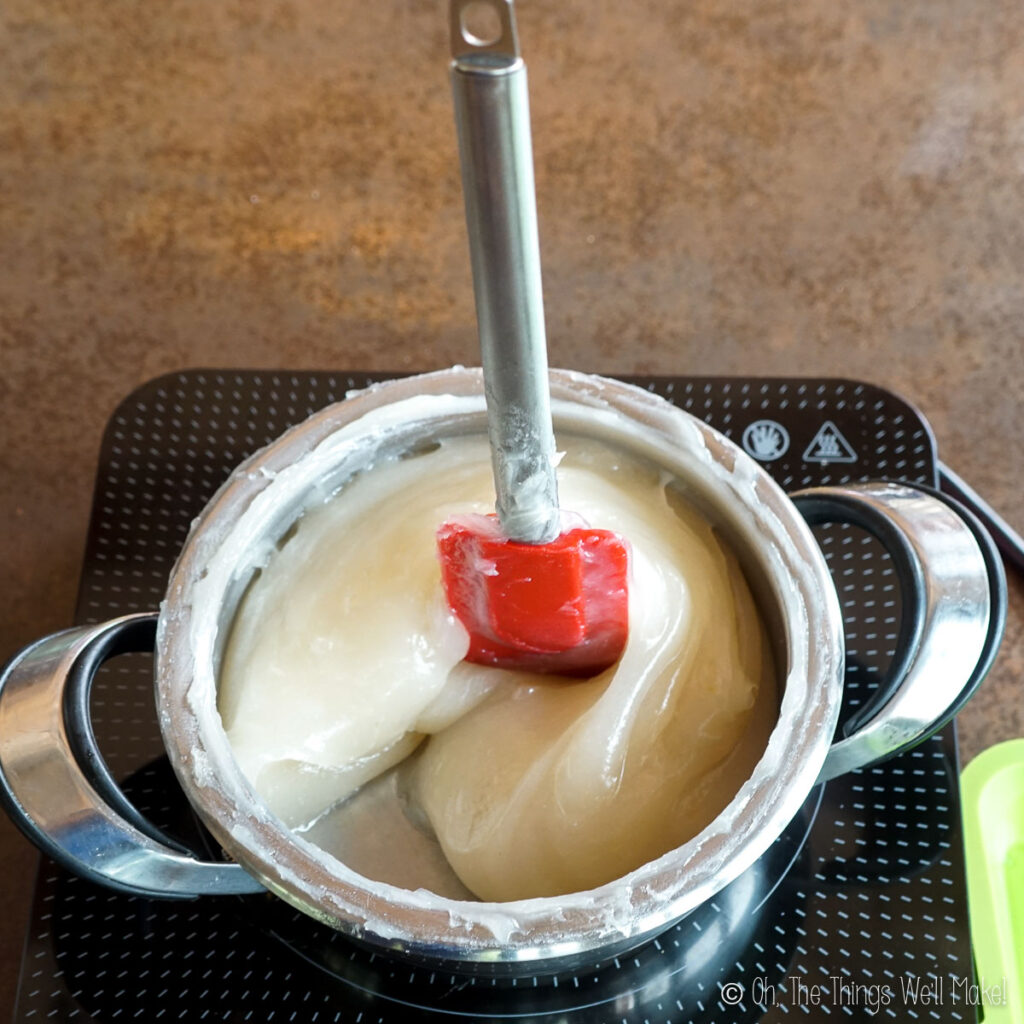

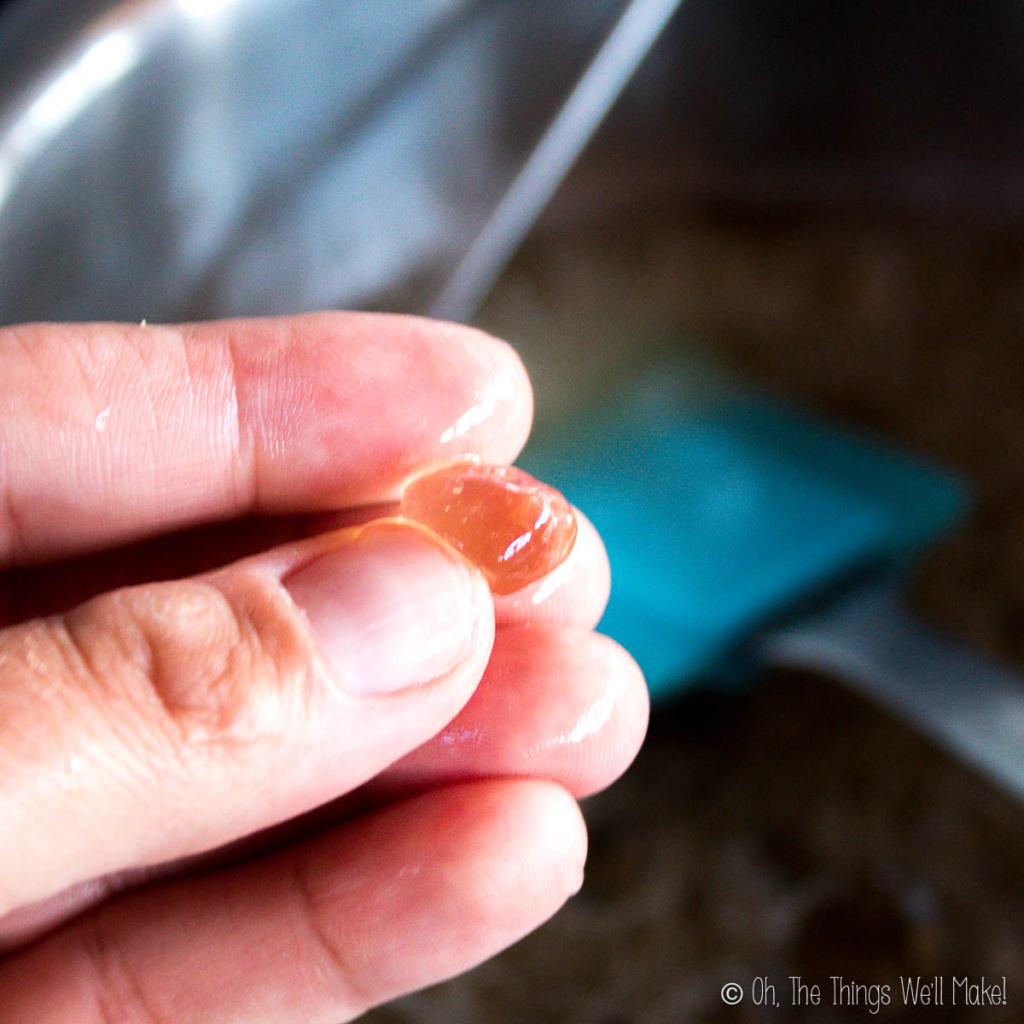
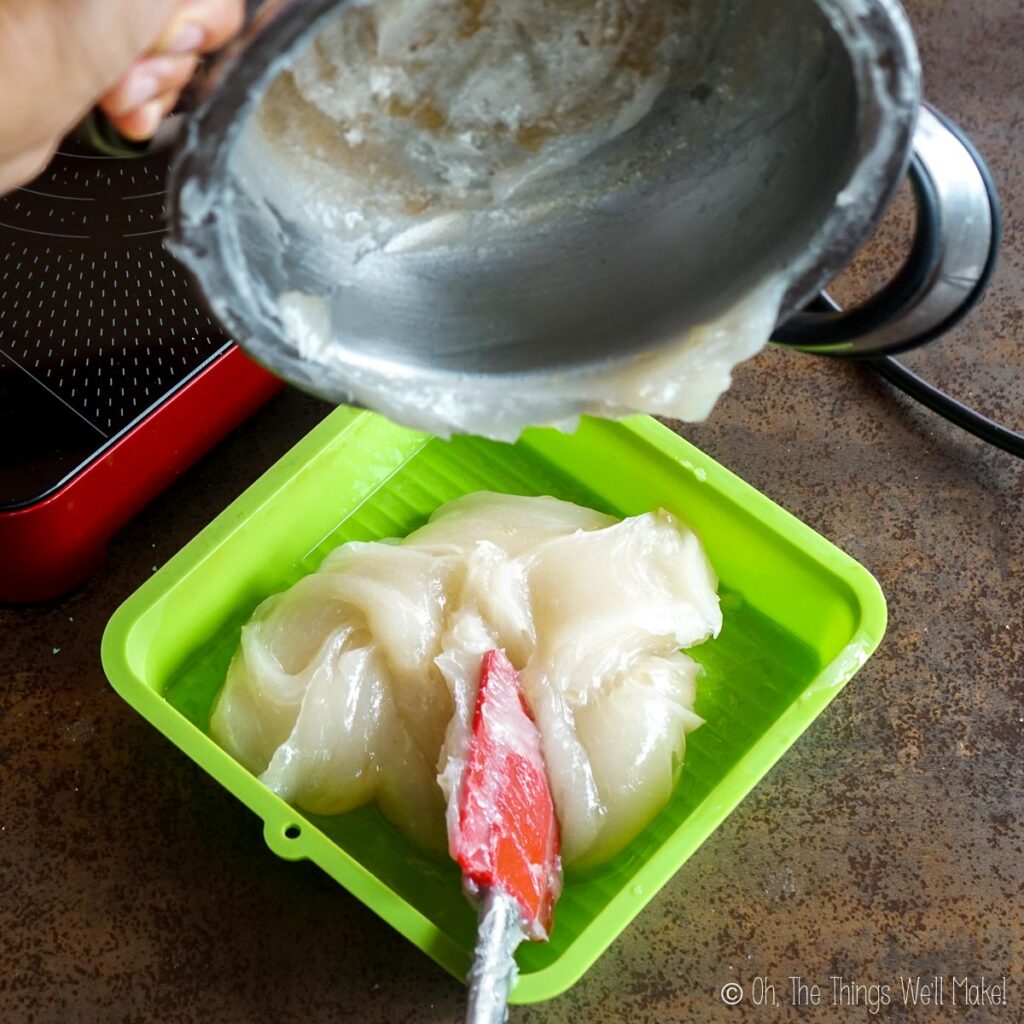
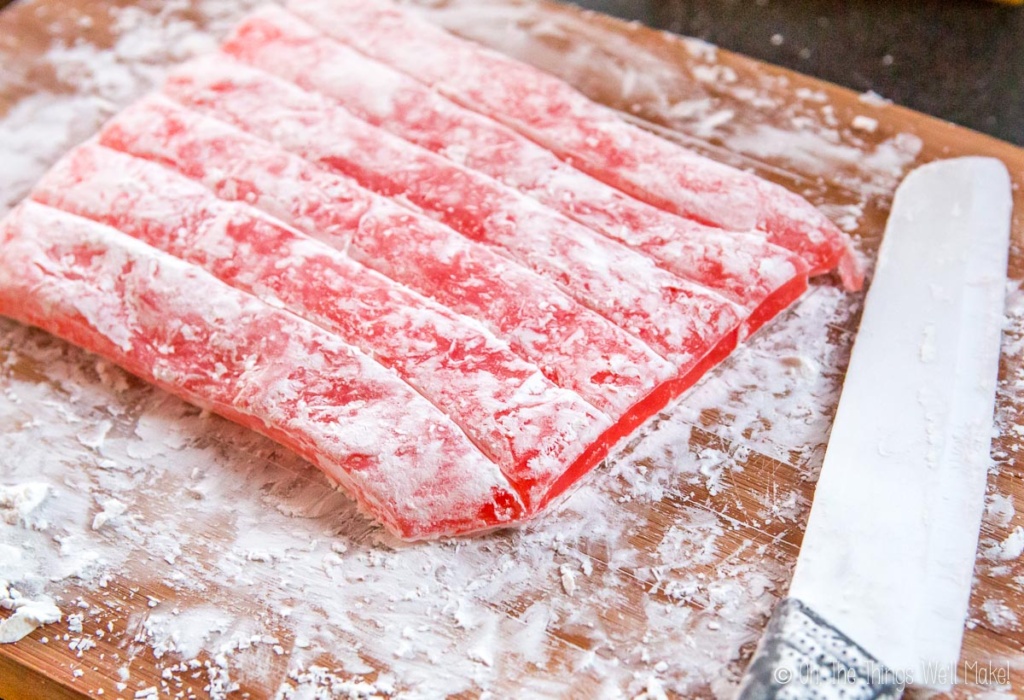
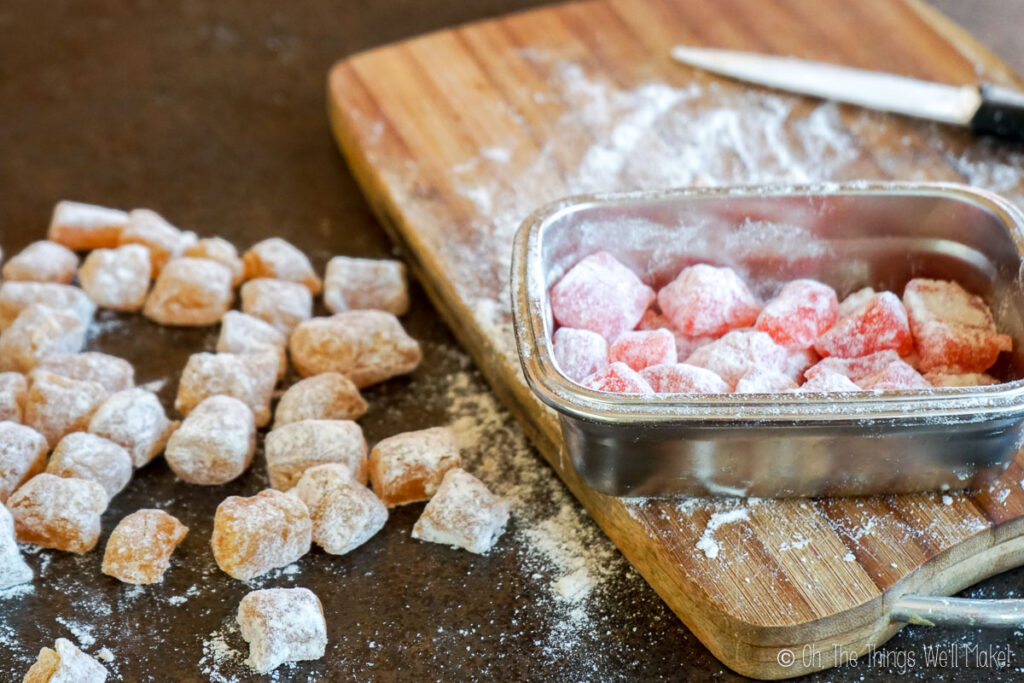
 Easy Mint Chocolate Fudge Recipe
Easy Mint Chocolate Fudge Recipe
Lorenna N
Looks very easy to prepare. I discovered Turkish Delight on my Istanbul visit last year. I fell in love with the taste and texture of this sweet. I have found good Turkish Delight varieties from Grand Turkish Bazaar but this time, I will try to make my own Turkish Delight at home. Thanks millions!! : )))
Tracy Ariza
Hi Lorenna,
I have been experimenting again over the last weeks and have found a better way to make this- using a bit of wheat flour too. I think the texture and flavor is better than the ones made with only cornstarch.
As soon as the holidays are over, I want to update this recipe with my findings. (Right now I’m busy finishing working on Christmas stuff before it’s too late.) 😉
Tim Sneed
I have a few questions have you ever had something called applets or cotlettes 2. are they the same as turkish delights 3.if they are then is it possible to make different fruity flavors such as four seasons, pineapple, etc… 4. do you know how you would incorporate those flavors into your recipe
Tracy Ariza, DDS
Hi Tim,
I’ve never even heard of them. Sounds intriguing, though.
I’m not sure about incorporating other flavors, other than to use either dried fruits or flavor extracts.
Bill
How long do you cook the cornstarch and syrup mixture for before finally adding the flavorings?
My last two attempts at Turkish delight, the directions told me to simmer for 45 minutes to an hour. It cooked down greatly in that time, bubbling steadily, but was impossible to whisk, it was so thick, so I used a wooden spoon.
With your method of adding the premixed cold cornstarch mixture to the boiling syrup, it actually thickened so much I couldn’t cook it more than about 4 minutes. Almost no bubbling was even visible.
I cut your recipe in half, figuring I only want to waste a cup of sugar at a time until I get this consistency right. We’ll see how this third attempt turns out.
Tracy Ariza
Hi Bill,
I don’t cook it for very long before adding the flavorings, but I do cook for a while once I add them in to reduce the moisture content as much as possible. That said, I have an update for you…
I actually was playing with this recipe again last week- and made 4 more batches. I’ll be posting my update soon- but meanwhile, I’ll tell you some of my findings.
1) I prefer the texture and flavor of Turkish delight made with both cornstarch and wheat flour. (Yes, I finally decided to try it!)
2) You can solidify the mixture more after the fact by baking it on low heat in the oven. This works for either type of TD.
Bill
I need to actually buy a box of Turkish Delight so I know what texture to shoot for…if I want to nail this recipe, I can’t fly blind, but it’s so cheap, I can’t help myself from trying over and over. I usually give up after 5 tries.
The recipe I used initially is the one from the YouTube channel Binging With Babish – his version is far higher in water and takes a long time to cook down. I like your method of adding the cornstarch paste while cold, it’s far easier to avoid lumps like can happen when you heat the paste into a gel & then add the syrup. I’ve also begun, since attempt 2, making this in 1-cup sugar batches so I don’t waste money & supplies on test recipes.
My attempts so far:
1) Babish (heated sugar to softball stage & simmered with cornstarch for 45 minutes) . texture was, as you said, more gelatinous than chewy, but it was perfectly tasty and fine.
2) second recipe (heated sugar to hardball state & simmered with cornstarch for about the same time). This version was far higher in sugar & included honey too – for some reason, it didn’t set up & was even softer than that stiff & gelatinous texture.
3) your recipe (heated sugar to hardball stage). After I poured in the cold cornstarch paste, the mixture thickened so much I could barely stir it, didn’t see bubbles when it simmered, and it began scorching on the bottom of the pan. Within 5 minutes I gave up and poured it into the mold – & had to end up spooning it in, because it had thickened so much. The final result was so soft, all attempts to dredge it with cornstarch were failures, as the sugar & syrup soaked right through each time. the pieces stuck to the container & this batch was a failure.
4) Babish recipe again (heated sugar to softball stage). This was mainly to just make sure batch 1 wasn’t a lucky fluke, and I got the same results (added almonds to this one just to make sure the texture stayed the same with added ingredients).
I plan on making three batches back-to-back next, one with sugar heated to softball, one with sugar heated to firmball, and one with sugar heated to hardball – just to see what the texture is supposed to be. (And I plan on having an actual box of the real stuff for comparison.)
Looking forward to your update. I’m just happy that I’m not the only one who goes a little crazy when trying to perfect a recipe…
but
amazing
Tracy Ariza
Thanks!
Tien
Firstly, I enjoyed your reply to Dan.
In your comment about what starch was originally used for me thinking about Turkish icecream and what wad used to make it chewy.
My online research for Turkish icecream recipe called for salep as the thickener.
Salep is a flour made from the tubers of the orchid genus Orchis (including species Orchis mascula and Orchis militaris). These tubers contain a nutritious, starchy polysaccharide called glucomannan.
Hope that helps. I was thinking of making your recipe but favouring with blood red orange. The mere suggestion had my husband going “yum”.
Tracy Ariza
Wow, Tien, that’s really interesting.
Too bad that’s not something readily available that we can easily find and experiment with.
I also like the idea of blood red orange for this recipe. We just planted a blood orange tree here at our house. Looking forward to the day we have our own blood oranges! ?
Dan
This is not a “traditional” recipe, not even close.
Turkish Delight (actually called Lokum) was originally made with Honey, Fruit Juice and Flour only, nothing else was needed to make it. It comes from the mid to late 18th century.
This modern corporate cheap rubbish we get today uses modern industrial shortcuts that bring most profit to the companies that produce it.
I take my hat off for you trying to back-engineer this product but, the recipe you give here is an Americanized version of the modern Turkish mass manufacturing junk that they try to pass off as Lokum.
“Don’t have citric acid or cream of tartar? You can get away with using lemon juice instead.” Lemon Juice is Citric Acid, its also called Vitamin C. You could use any citric fruit, just squeeze some fruit and it will be fresh, clean and it will have more flavor.
No cornstarch needed but America must get its corn sales. Corn products also change the flavor of products, I never use it.
If you want to dust it then use rice flour. Corn flour / starch interferes with flavors as well as the color of food.
As a general tip for everybody, Artificial Red food coloring from most food company sources is toxic. The two most common Red food dye sources are from a crushed beetle called Cochineal and the other comes from Coal Tar !!! both are known Carcinogens. You can get natural food dye that comes from other food stuff and its 100% safe.
Always look up ingredients so that you know what you are eating. Some “food Additives” are very toxic that will deteriorate your health over time. It will catch up with you in later life and it will effect your children because you messed up your reproductive system by consuming these toxins. Then you feed your kids these toxins on top of that. You may want to look up the effects of plastic too. It was proven in the 1950’s that plastic is toxic. No such this as safe plastic for food containers etc. Plastic can change hormones in your body. That can lead to, among other problems, birth defects because your body is contaminated.
The jury is still out regarding if Silicon is safe but given that you can get silicone poisoning… my bets are that its not a health tonic. Use traditional wooden, stainless steel, Pyrex glass or ceramic to avoid contamination in the kitchen.
You also want to avoid Aluminum pans, even more so when using acidic liquids. Aluminum gives you brain damage that is irreversible. It has been linked to various forms of Alzheimer’s, most commonly dementia.
Always remember, you are what you eat. Keep it clean and GMO free.
Avoid Plastic like the plague as it is very toxic to your health.
Tracy Ariza
Hi Dan,
I called this recipe traditional in that it uses a starch, water, an acid, and sugar vs. thickening with gelatins or some other modern thickeners not originally used.
I actually did a lot of research when I was writing this, and watched videos/read articles of people in Turkey in the surrounding areas to see if I could figure out the secret to getting it right. (I spent many days making different versions of the recipe over and over again.)
When I researched traditional lokum, I wasn’t able to find out any information about which starches may have originally been used. They always just say that lokum is a sweet gel candy made with starch, sugar, and acid.
I was also surprised by the corn, but all of the Turkish delight I saw for sale in Turkey also used cornstarch. (Yes, perhaps, it’s been modernized, but, again, I can’t find what alternative may have been used before.) I went by the ingredients of the packages of lokum that I bought in Turkey. I’ve actually never tried American Turkish delight, so I can’t really compare. (Yes, I grew up in the US, but I’ve been living here in Europe for more years than I ever lived there.) I don’t really know what they use over there to make it if they don’t import it (but, yes, corn is always a mainstay in the US). 😉
I understand that lemon juice contains citric acid, but this candy is very finicky to make and the tiniest variations make a huge difference in the outcome. That’s why, by the time I published, I tried to go with the most consistent way of doing things. I began by trying to make it as natural as possible. I colored it with some homemade beetroot powder. (It actually looked pretty good.) I used lemon juice and rose water. Too much water was making it soggy, though, and not the right consistency- so I moved to less natural means.
If you read my blog, you’ll notice that this post is very different from the sorts of things I normally make. (I usually choose completely natural, healthy, from scratch, real foods!) This was mainly me being stubborn and wanting to try to make something of something I would normally never even buy. I don’t eat a lot of sugar and only bought the Turkish delight because I was in Turkey and it was everywhere. So, my curiosity was piqued, of course. I eventually had to give up because I get sick when I’m in the presence of so much sugar.
I actually even considered deleting the post, but it became so popular that I didn’t have the heart to. I wanted my experiments to not have been in vain and, at the very least, help someone else who is on the search for a way to make Turkish delight.
For years, I have been meaning to update this post- improve the recipe, try to find a more natural way to make it (successfully), etc. (Would arrowroot or tapioca starch work? What starch that thickens like this would be more local to that area?) I have so many questions about it that still need answers, but it’s really hard for me to push myself to work with this much sugar again because I often get really sick these days when I do. (I’m actually recovering this week after making my son’s birthday cake last week! I was tempted to just order one elsewhere this year, but I figure making him a cake once a year won’t kill me. I made it with organic spelt, organic panela, eggs from my hens, etc. because I wanted the best for him.)
I, like you, avoid as much plastic as possible. I have also read more about silicone pans since writing this post. I’ve come to the conclusion, from what I’ve read so far, that silicone is generally safe while cool, but using it for cooking is the great unknown so I have since been more careful about using it too often with heat, just in case. (This is covered in one of the books I reviewed on the blog, Green Enough by Leah Segedie.)
I love silicone pans for making soap, and think that for a recipe like this one, it’s the most practical. I think a good way to reduce the possible toxicity of any mold you may use is to line it with parchment paper. It makes for easier removal and clean-up anyway.
So, in a way, you are preaching to the choir.
I pretty much agree with everything you say. I’m wondering what “flour” you think was traditionally used, though?
Dan
Hi Tracy,
Starch = Flour
Honey = Sugar
Acid = Citrus juice
My understanding is that Lokum gel is a reaction between the flour and the honey. Honey is a preservative but it turns watery when you add food to it for preservation.
You get interesting honey in Turkey that is like no other in the world.
As for flour sources in the late 18th century Turkey my best guess is Wheat or Rice. Both will gel in the right conditions. There is also something Turkish called Salep flour that I need to look more into. It is hard to track down accurate info on this, the internet becomes more useless every year for research.
Again this is for the Original Lokum. “Turkish Delight” is just a marketing term/brand of a cheap industrial corruption of Lokum.
Turkey appears to own much of the Wests confectionery so I suspect its much the same in the EU as it is in Turkey. As for America, I’m not sure if its made there but you can find it on the Brit section of a shelf in the grocery store. Given what Hershey passes of as confectionery I think I will pass. American food quality is some of the worst in the world, certainly the top 5 worst nations.
Using other methods to make the Turkish Delight version of Lokum, I think Agar (agar-agar) might be the solution. Arrowroot can be made into a gel, Sago is another. I have seen tapioca in Asian drinks that might work, look up Taiwanese Bubble tea.
Corn starch is cheap and nasty stuff, that is why they use it, max profits.
Color :
Maybe its better to make a solution of the beetroot and filter the solids out ?
The solids could mess with the results, or make no difference at all. It is probably your best go to for Red or Rose but I’m now thinking of pomegranate…
Turmeric for the yellow/orange.
Lime has its own color too but that needs to sit for a day or so in a jar in the fridge to settle the sediments if needed.
If your solution was too wet I suggest making a simple syrup from those flavors and colors. Simple syrup can be turned into hard candy so you should be able to get the right viscosity needed to add to the rest of the ingredients.
Not something I buy but my buddy brought some so we had coffee and had a chat about the confectionery. It is best served with strong black coffee. That lead me to thinking of digging up a traditional recipe to mess around with. I like to back engineer foods that I cant buy here, or when what is available is trash quality. Discovering how to make Tomato ketchup was a surprisingly tougher challenge than I expected.
I do like the sound of that spelt cake. I’m a big fan of spelt bread.
It is good to get a challenge in the kitchen once in a while, it is like playing harder to play music, you get better or just give up and learn to paint instead = X D
I put the bit in there about toxic utensils and such just to help all those reading recipes in general of the dangers that mostly go unseen until its too late.
We have just seen two drugs get pulled off the shelves because they are “unsafe” yet they were passed by “experts”, even tho they already knew about Zantac back in 1995. Somebody also once said that it was ok to use lead water pipes too even when they knew it was toxic = 8 O
Don’t be surprised when silicon utensils are added to that list.
Question is, how did the Turks make it in the 18th century, way before plastic or silicone ?
I don’t think they even had rubber back then.
Keep trying, you will get it. If a crappy factory can make it and 18th century Turks well… we are in the 21 century with lasers and everything… “should” be easy.
Sorry I like to clarify time to time, its the analyst in me.
When I saw “Traditional” I hoped it was an original recipe. “Traditional” implies the “Original Standard that is continued without change”.
Words are becoming meaningless like “Awesome”, “Gourmet”, “Spicy”, “Liberal”, “Unique”, “Tactical”, “Democracy”etc., these words are losing their original definitions but we need those definitions so that we can converse with more accuracy using the right expression. That way we understand each other. If language has no rules then we may as well just regress to grunting no ? = ; p
Philippe Charron
The pictures look awesome but I can’t get it to thicken up like it says it should. I had the cornstarch and water mixture as per the instructions but it stays watery. I’m not sure if anyone else figured out what the issue is?
Anonymous
Turkish Delight will never set or be firm without gelatin. Tracy should be ashamed for misleading the readers of her blog. Shame on her.
Tracy Ariza
Why are you hiding behind “Anonymous”? (And an anonymous email.)
The way you wrote your comment towards me made it tempting to just delete it and move on with my day. (I don’t accept derogatory comments. This one didn’t cross the line, but almost.)
Still, in the off chance that you actually come back here to see if your comment was posted and if I responded, I decided to leave it up and address it.
I assure you that you absolutely do NOT need gelatin to set Turkish Delight nor does the traditional version use it. The cornstarch is a thickening agent, and when you mix it with water or another liquid and cook it, it thickens. That’s how you thicken sauces like gravy, and, in this case, by adding more cornstarch, you can make something firm enough to cut into squares.
Yes, you can add some gelatin to make a different, less authentic version of Turkish Delight, but the version with gelatin doesn’t keep as long and would need to be refrigerated. (Again, unlike the traditional dessert.)
You can clearly see in my pictures the results of my different experiments (none of which used gelatin), and I think it’s quite obvious that it is firm. (In fact, with some of the attempts where I cooked the sugar too long, it ended up getting too firm, especially if I stored in the fridge.
I’m not ashamed of telling my readers exactly what happened when I did each of the experiments. I have also asked readers for tips and tricks to improve this recipe as I find it very finicky and unpredictable, and I’d love to update with tips for getting it to always turn out right.
I also want to update this post with a video (where you’d see it firm up).
If you check other Turkish Delight recipes (and videos), you’ll see that it does, in fact, set perfectly without gelatin.
Perhaps you should try a recipe before unfairly criticising it (and me).
Guy
Hi Tracy, just wanted to support your last comment. I love TD and in conversation with several sellers in Turkish markets, gelatin is used in inferior, low quality Turkish delight. The quality stuff doesn’t use it. Taste tested LOADS of it and they don’t lie !
Tracy Ariza
Thanks, Guy! ❤️
dinos
hi i’m from greece and i can only say to a roud guy like you (your full of sh..t) if you haven’t try lokoum then keep your brain shut as it was!!!!!!!!!!!!!loukoumi DOESN’t have gelatin ge-ge?
Water
I tried to make the Turkish delight. The flavor was good but after I put it in the fridge, it went to this stage jello like texture. When you pull it apart, ithe just instantly breaks instead of stretching. I kept it in the fridge for 2 days and after that there was a lot of water around it. I think I had too much water. Is that the problem or is it something else I’m going for a second try so fingers crossed.
Tracy Ariza
Hi Water,
Storing in the fridge will make it much harder. I had some batches get too hard in the fridge too and had to leave them out. Or, you can take it out a while before serving.
Jenny Westmacott
Thank goodness for you, I was determined to get this right, having tried a recipe from “Taste” that was disastrous, I came across your site and tried your version, it was actually a lot easier and turned out beautifully, thank you so much, if you were here I would kiss you lol
Tracy Ariza
Hi Jenny,
I’m so happy to hear it worked out well for you. I still want to go through and try to perfect it because I’ve found that, as written, it doesn’t always turn out the same way every time. Sigh. 😉
Abby
Always try again if it doesn’t come out the why you wanted to because you my get good at it before you know it